SEO PRICING

Check how my SEO strategy works, in full depth.
Choose from my 4 monthly SEO plans.
Your business is about to experience something new.
This is what is going to happen:


New clients will land on your website, growing exponentially.They'll find helpful content, whether they're buying or seeking information, and feel satisfied.They'll see your product/service and be driven to convert by its strategic presentation.
And it is going to look something like this:
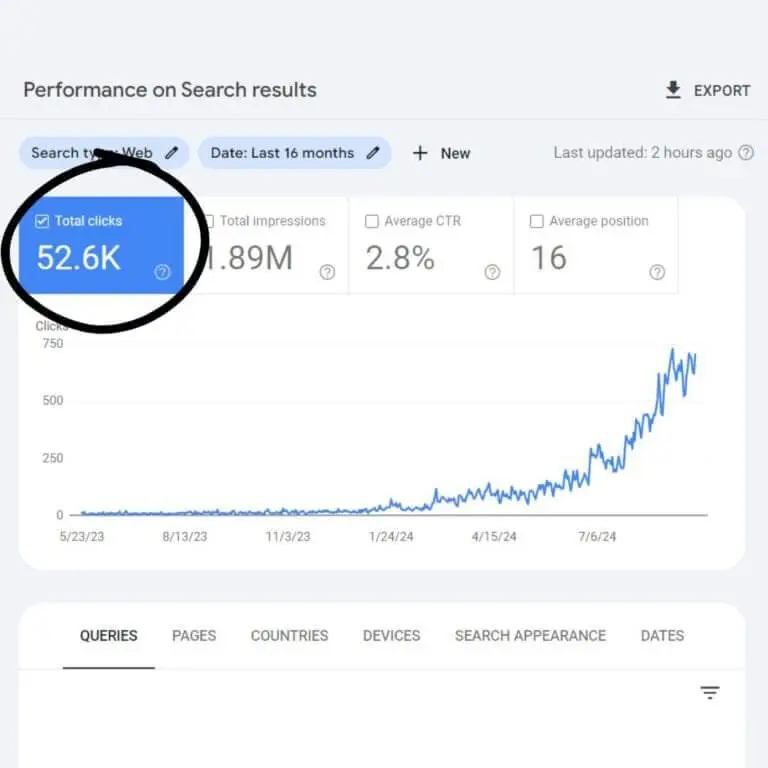
More new potential clients, that are thoughtfully and strategically identified and targeted, will come in your website with SEO (Search Engine Optimisation).
More of those potential clients will do what you want them to do (Conversion) in your site with CRO (Conversion Rate Optimisation). And yes, that 20 million USD you see there is real, I was surpised to see it too, it is a big client.
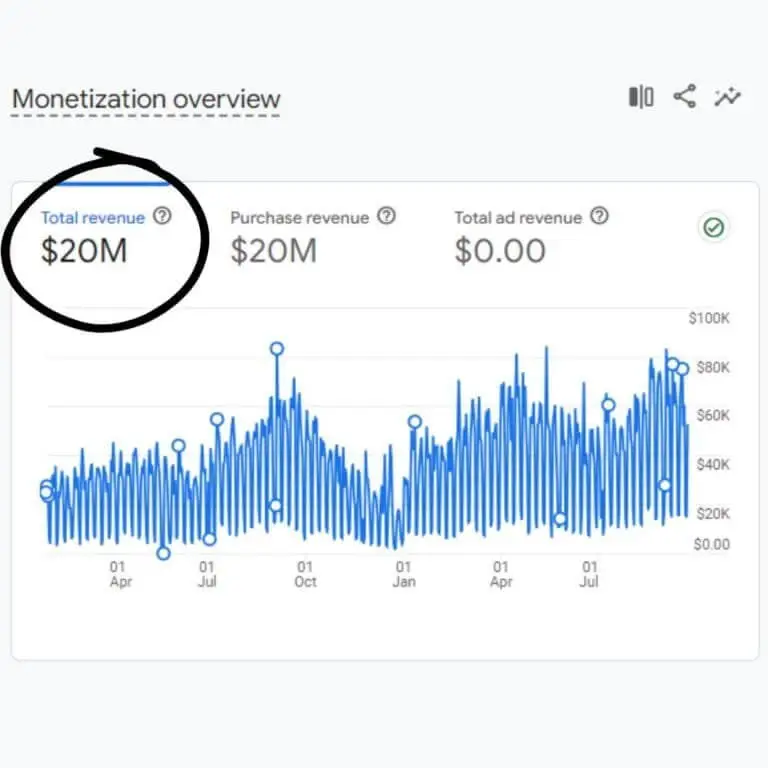

Everything will be analyzed with the custom made Performance SEO Report where you can clearly see the situation, how everything is working and a summary of the tasks I have done.

I would not really categorise working with me as having someone you pay to make specific SEO tasks and see if they work.
But rather like:


Having a brain behind your website, that makes strategic and data driven decisions to bring more potential clients that Convert.An extension of yourself and your team.
And, innevitably, what ends up happening are these huge SEO results and spikes in potential clients coming to your website:
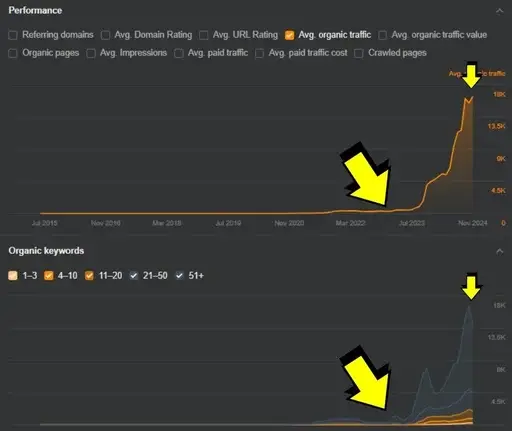

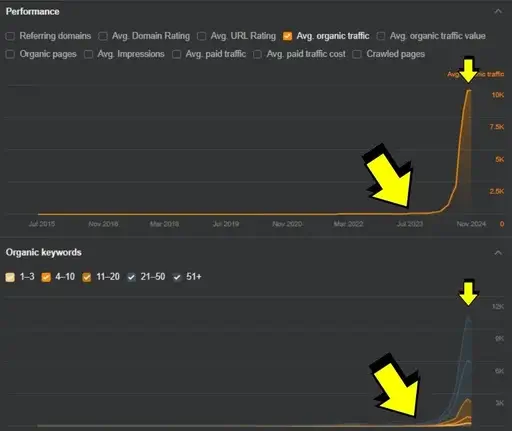
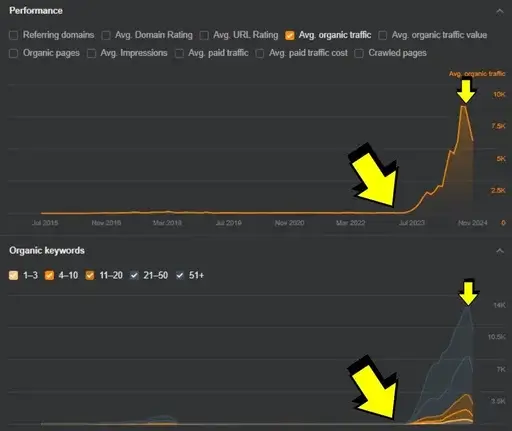
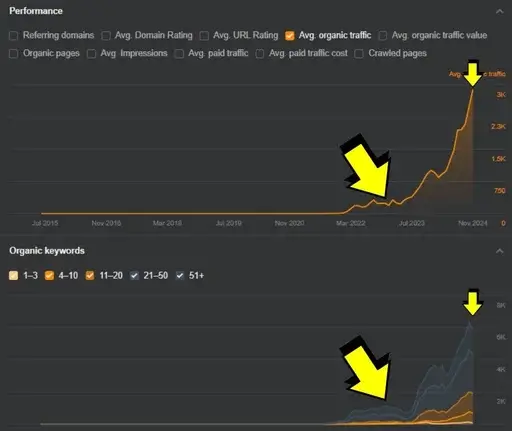
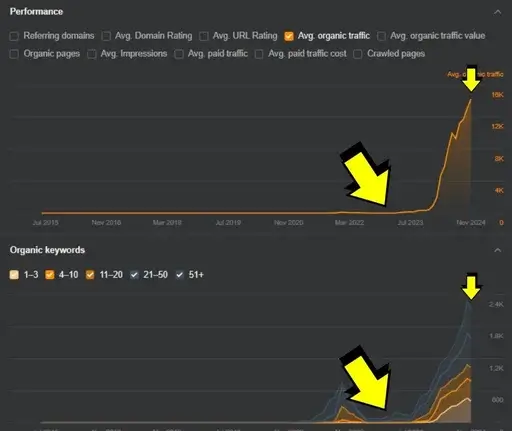
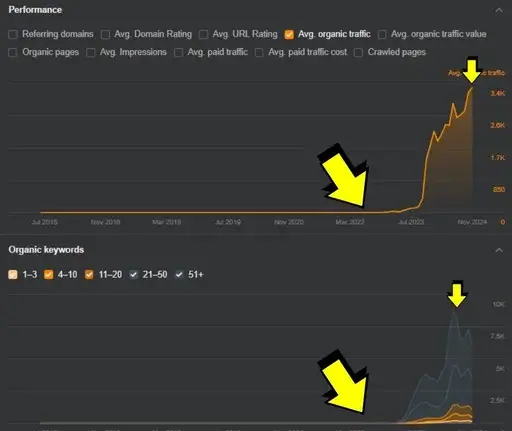

SEO Max:
35 to 14
SEO pages a month
36 hours a month in SEO tasks
Click to see video:
From 35 to 14 Pages A Month
(Why A Range?)
Google My Business Optimisation
Linkbuilding Approach
Youtube SEO
Social Media SEO
SEO Pro:
25 to 10
SEO pages a month
27 hours a month in SEO tasks
Click to see video:
From 25 to 10 Pages A Month
(Why A Range?)
Google My Business Optimisation
Linkbuilding Approach
Youtube SEO
Social Media SEO
Not included in this plan:
Opportunity Research
AI Overviews & Methodology
SEO Lite:
15 to 6
SEO pages a month
18 hours a month in SEO tasks
Click to see video:
From 15 to 6 Pages A Month
(Why Range?)
Not included in this plan:
Google My Business Optimisation
Linkbuilding Approach
Youtube SEO
Social Media SEO
Opportunity Research
AI Overviews & Methodology
SEO Ultra
50 to 20 SEO pages a month
45 hours a month in SEO tasks
Click to see video:
From 50 to 20 Pages A Month
(Why A Range?)
Google My Business Optimisation
Linkbuilding Approach
Youtube SEO
Social Media SEO
WHAT'S INCLUDED IN THE SEO PLAN?
The 9 steps in the process
Let me inmerse you in the 9 pillars of the SEO strategy with clear and understandable explanations in the quick videos below.
As well as, below the 9 steps, a full glossary of all the tasks:
3.
AMOUNT OF SEO PAGES CREATED PER MONTH
9.
STRATEGY ADAPTATION FOR YOUR INDUSTRY
Below you can see the full glossary of tasks that will be executed thoughout the strategy with indepth explanations for each one:
- Research
- Page creation
- Analytics
- Technical
RESEARCH
We go into full-on crazy-scientist mode where we spend several hours looking at the ins and outs of your website.
From Google Search Console, to Screaming Frog, to navigating through the site, and more. All with the goal of seeing what SEO success has been achieved, to make sure we don’t kill it with any part of our strategy.
This task also greatly helps us get an initial understanding of the project and niche, with all its nuances.
This is where we go from beginner to master within your niche.
We begin to research and brainstorm the semantic logic of what you do and what you sell, then expand to understanding the potential buyers and psychological needs people have, and link it all up by understanding the SEO world of your industry and niche.
Out of many, we use the tokenization technique to gather and digest all this data as fast as possible.
Funny enough, we somehow always manage to begin very stressed with this task because we have to deal with huge amounts of data, each of it very mentally demanding to understand, which we don’t understand clearly. But we end up extremely happy and ready to take on the SEO-world of your niche due to having understood and categorized all the data within your industry accordingly. Here’s an example.
When you export keywords in SEO tools, you can add an ‘included’ or ‘exclude’ rule.
This makes sure that you only export what is relevant to your niche, without exporting irrelevant stuff.
Here, we have to find a perfect equilibrium between exporting as many relevant keywords as possible, and as few irrelevant ones as possible, and meanwhile not miss relevant ones due to being too restrictive with our filter rule.
Believe us, this is harder than it sounds, but when it’s done right, and as we always say, you manage to find the gold within the river of keywords. And we say river of keywords because there’s more than enough (1000s and 1000s) to fill a river if you don’t filter correctly. Here’s an example.
Now it’s time to turn the brainstorming and filter rule task into reality.
We turn the brainstorming information into a structured set of instructions to add the correct keywords as seeds to find relevant keywords, and the correct filter rule to find the gold.
Whatever we don’t consider here to export might never be exported, and that’s not great. So we have to make sure that we set up a system where we have the correct keywords as seeds, and the correct filter rule, to make sure we don’t miss exporting anything.
If we do, we still have a backup though—the SEO competitor exporting technique—but we don’t like to rely on it to find the gold. Oh, and by the way, we even have another filter if any keywords are not found with these two techniques, which is the opportunity research that’s an ongoing task. No keywords will hide from us! Here’s an example.
Boring task, but crucial.
We essentially spend hours searching the seed keywords we found in our brainstorming in SEO tools, adding the correct filter rules, and exporting all the keywords we find.
Then we merge the 100s of CSV files, erase duplicates, and proudly admire the 100s of 1000s of keywords we’re going to use in our strategy. As well as being happy that we are done with it!
We find your SEO competitors. But not only that, also competitors you didn’t even know about. But why stop there?
We also find semi-competitors, which are websites that might have overlapping business competition with you, and they might be ranking for stuff you also want to rank for. And finally, SEO competitors which are not business competitors, like blogs or forums.
These tend to be very relevant to finding informational searches people make around your product or service. Here’s an example.
And now it makes sense why we exported so many competitors.
It’s time to steal their keywords. We export the keywords they rank for, or in other words, their SEO strategies. This way we make sure that if any of your competitors are doing well, we know about it and will execute on it too.
Exporting all the SEO strategies, of all your competitors, within different levels of ‘competition,’ ensures you know everything that’s going on in the SEO world of your niche and that you can execute a strategy that’s better than any individual competitor of yours. Remember, we add the keywords found from the seed keyword technique too, so if any keyword exists that none of your competitors have targeted, we’ve got them too. Here’s an example.
Now we have keywords from the competitors and the seed keyword technique, so we have to clean up our data a bit more to make sure as little irrelevant stuff appears as possible.
You’d be surprised at the amount of irrelevant (and weird) stuff that people search on Google that leaks through when exporting, even with a firm exporting filter rule!
Surprisingly, we can’t do much with 100s of 1000s of keywords.
Because we have to cluster them, and this is absolutely crucial for SEO success. We essentially obtain the top websites ranking for every single one of the keywords we’ve found and compare all these results to one another. If there are overlapping results in 2 keywords, we cluster them together; if not, we separate them. Sound simple, right?
Well, we’ve just reverse-engineered Google to drastically increase the chances of SEO success. Because when 2 keywords are searched, and Google doesn’t rank similar websites—thus there are no overlapping results—Google is clearly telling us that to rank for these 2 keywords, you can’t do it with 1 page, so you require 2 different pages, and vice versa as mentioned above. We execute this with several AI techniques and algorithms, but mainly using a tool that costs several 100s of Euros in credits to execute, but this is a charge that is absorbed by myself. How nice of I, right? Haha. Here’s an example.
All these keywords and clusters are placed, neatly and in a structured manner, just how we like it, into a master file.
This file contains the whole strategy for months (and sometimes years) to come.
It crucially also has important data like keyword difficulty, search volume, whether the cluster (and keywords inside the cluster) is searched by people with a need to buy or those looking for information, whether you already rank for the cluster/keywords, and more. Here’s an example.
All this data mentioned above, as well as the obvious critical data of the cluster and keywords themselves, helps us compare everything relative to one another and not only understand what strategies we’re going to execute and create, but also which to prioritize first, with the mindset of achieving SEO success (obtaining quality traffic that converts, a lot) as fast as possible. Here’s an example.
New task! Think of it as this: an ongoing task where we’re trying to find any keywords (and thus clusters) that we didn’t find in the initial research.
So, in a funny way, we’re testing if we did a good job initially, right? Haha. Well, sometimes we might find new stuff due to this reason, as initially is technically the moment we know the least about your niche.
But to our defense, there are other reasons why we might need this task. Sometimes we might find new buyer personas months into the strategy, or you start to sell a new product or service, or a trendy topic appears that didn’t exist when we did the initial research. Or hopefully, we might work for so long that we end up executing and creating all the pages from the initial research!
Surprisingly, we find many keywords/clusters and pages to create with this task, and it’s an incredibly valuable addition to the strategy. Here’s an example.
PAGE CREATION
We can trust our research and website architecture, but we’d rather check it all with our own eyes before we go and create any page.
This task involves cross-checking the cluster and the keywords inside it, making sure they should indeed be clustered, and most importantly, analyzing the search results that appear when people search those keywords to decide if it’s worth creating the page or not. We focus on the difficulty to rank by viewing the ranking websites’ ‘SEO power,’ whether the results are truly targeting the intent of the searcher, and more.
A big one here is also checking that the page hasn’t already been created to avoid the terrible mistake of triggering an SEO cannibalization issue, where both pages (the one you have and the new one) rank poorly because Google gets confused about which one to prioritize. Here’s an example.
The task above has so many variables to check, so our job is to make it very clear to you why we should create the page, normally with a quick Loom video, and simplify this information for you to verify we’re good to go and create the page.
We also make sure that the SEO page passes any legal/business filters you might have. Sometimes an SEO page might be a great opportunity, and you might even agree, but we simply can’t create it due to legal/business reasons you might have in place.
If we had to explain everything we do here, it would take a lot!
In simple words, we do another ‘mini research’ on a page/cluster basis to extract even more data than what we found in the research—like competitors’ content currently ranking for the cluster/keywords, AI Overviews that Google shows, PAA questions, and more. Then we use AI to digest and organize all this data for us.
Importantly, AI works only with our data; we don’t ask AI to come up with its own because that could cause big problems. Finally, we end up with a beautiful, neat, and structured Google Doc that is SEO optimized to the max and ready to be written by a writer. This is the closest we can get to actually writing it ourselves, as the writer has every single thing needed to write all the information in the way we want it. Here’s an example.
We send all this information and Docs to the writers with extra guidelines to ensure that the result is exactly what we want/expect.
We also constantly track the status so deadlines are met. Here’s an example.
We trust the writers, but we trust ourselves more, so we’ll gladly check that every single thing we’ve asked for has been executed accordingly.
If not, we handle providing the feedback, ensuring it is implemented, and making sure we provide the learning points for the writer to improve for next time.
All this entails small details like bolding the most important words of a paragraph, to crucial steps like making sure the H2 titles answer briefly and directly to increase the chances of getting an AI Overview mention or Featured Snippet in Google. Here’s an example.
This is where the devs come in. We provide all this information in a neat manner to make sure it can be transferred to the CMS (like WordPress or Shopify) and do it in a way/language that devs can easily understand.
What do we mean by this? Over the years, we’ve learned how to be very clear, direct, and mindful of the little details when communicating with devs to make sure they do exactly what we say—nothing more, nothing less.
You’d be surprised by this, but around 50% of the time we send the pages to be uploaded in the CMS, there are issues or mistakes with them.
Do we explain ourselves incorrectly when we send instructions to the devs? Perhaps, but we work very hard to avoid that. Are the devs focused enough to avoid mistakes? Maybe.
Regardless, the solution is always adding layers of checks to increase the chances of going live mistake-free. We check every single detail during the dev stage and again when the pages are live.
This tends to be a one-time task.
Over the years, by reverse engineering competitors and studying websites in various industries, we’ve developed a ‘blog’ template that has the most on-page SEO-optimized structure and the highest-converting structure, drastically increasing the chances of transforming users who land on the blog/informational page from information-seekers to buyers.
This involves strategic CTA creation and placement, dynamic content outline anchor links, smart SEO internal linking widgets to stimulate correct internal linking patterns, and over 35 unique features that together achieve great rankings and high conversion rates. Here’s an example of the blog template execute with a client.
We are SEOs, not developers.
We can’t develop the blog template or design it, but we can create the most in-depth and complete set of instructions so devs can bring it to life as efficiently as possible.
This involves creating a Google Doc structure that describes every single element in the blog template, along with video explanations and links to it being created with other clients. We also include clear instructions on how it should look and function to meet the guidelines.
Normally, the devs create a design, we check it, then it gets developed, we check it again, and the template is ready to be reused every time we create a new blog/informational page. Here’s an example of the blog template execute with a client.
While we can say with 100% certainty what template and page design your blogs/informationals should have, we can’t say the same for your transactional page template.
Each transactional template is its own world—some are category pages, others are landing pages, and each can look drastically different. This is why we conduct research geared toward understanding the design and structure these transactional pages will need.
We do this by reverse engineering the design and structure of successful competitors ranking for these transactional keywords and carefully curating every section that might be of interest to add to our page. We also leverage AI to understand what types of people will land on these pages, what psychological pain points they have, and what we should display, how it should look, and what we should say.
All this is done to satisfy user needs (and Google), increase conversion chances, and improve our ranking. Here’s an example of the blog template execute with a client and the Docs we used to create it.
We aim to create as many transactional pages as possible each month. To do that, we need to be smart about it. The number of SEO pages we create every month depends on the plan you choose and the word count included in that plan. Therefore, the less unique word count needed per page, the more pages we can create within that capped word count. We’re incentivized to create as many SEO pages as possible each month because the more we create, the faster we’ll see SEO results, and the longer we’ll work together. For this task, we blend research to find out how the page should look and work, determining how much unique word count is needed per page and how much content can be duplicated or used dynamically, and where all this text will go. The goal is to achieve the perfect balance between having enough unique/valuable content for SEO success and leveraging techniques to minimize the amount of unique text needed so we can create as many SEO pages as possible. Here’s an example of the blog template execute with a client and the Docs we used to create it.
We are SEOs, not developers. We can’t develop the transactional template or design it, but we can create the most in-depth and complete set of instructions so devs can make it a reality in the most efficient way possible. This involves creating a Google Doc structure, which describes every single element in the transactional template, with video explanations and links to examples created with other clients. We also provide clear instructions on how it should look and work to meet the guidelines. Normally, the devs create a design, we check it, then it gets developed, we check it again, and the template is ready to be reused every time we create a new transactional page. Here’s an example of the blog template execute with a client and the Docs we used to create it.
ANALYTICS
Surprisingly, some of Google’s own tools are quite limited if you want to execute an SEO strategy efficiently.
Luckily, they have a tool called Looker Studio where we can create our own reports, using your own data. In this report, we track the main KPIs (goals) of the SEO project: Exposure (the number of keywords we rank for and the impressions they generate from Google Search Console), Traffic (clicks from Google Search Console), and Conversions that the traffic performs (conversions and events from Google Analytics).
Additionally, we track minor data points like keyword trends, unique keyword positions, and more. For complete transparency, we also provide the whole list of tasks we’ve executed that month. Here’s an example of a report from a client (I don’t work with this client anymore so please ignore any drop you might see in their graphs).
Whether or not you’re already tracking conversions inside Google Analytics, to track the conversions coming specifically from SEO, several unique actions are needed to ensure it’s being done correctly and accurately.
We handle this by leveraging Google Analytics, Google Tag Manager, and Google Looker Studio. This way, you’ll be able to see how many conversions the SEO strategy is bringing in, but not only that—you’ll also know which SEO strategies, pages, and keywords are driving those conversions. It’s very granular, providing a clear picture of what’s working and bringing you more business and ROI.
Here’s an example of a report from a client (I don’t work with this client anymore so please ignore any drop you might see in their graphs).
This is where we dive into all the data we’ve accumulated over the week and analyze it in detail.
We’ll be looking at everything from traffic trends to keyword rankings, search impressions, clicks, conversions, and even how individual pages performed. The goal is to understand exactly what’s working, what’s not, and where we can optimize further. We use tools like Google Analytics, Google Search Console, and Looker Studio to spot any patterns, unexpected changes, or opportunities we might have missed.
It’s not just about looking at graphs—this is the hard stuff, where we analyze every movement to figure out how to get even more out of the SEO strategy. By the end of this task, we’ll know which tactics are hitting the mark and which ones need a tweak or overhaul, so we can keep pushing towards big SEO wins.
This task is all about ensuring everything we’ve worked on goes live smoothly and performs as expected.
After the pages are uploaded to the CMS, we’ll be double-checking every single one to ensure there are no mistakes—whether it’s broken links, formatting issues, or SEO elements not implemented correctly.
We’ll also keep an eye on how these pages are being indexed by Google, tracking their performance from day one. If there’s an issue, we’ll catch it early and make sure it gets fixed quickly, because the last thing we want is to miss out on potential rankings or traffic due to small errors. We might also index via API if we notice that Google isn’t indexing the pages at the speed we want.
This monitoring phase is crucial for ensuring the strategy we’ve planned is executed flawlessly and delivers the best possible results.
In SEO, things can fluctuate, but it’s all about understanding why something spiked or dropped, and if there’s something within our control we can do to positively influence these trends.
This task is focused on identifying and understanding any fluctuations in your website’s performance, whether it’s a drop in rankings or a sudden increase in traffic. Using tools like Google Analytics and Google Search Console, we analyze key metrics—such as keyword positions, impressions, clicks, and conversions—to pinpoint the causes.
For any drops, we investigate whether they’re due to external factors like algorithm updates or internal changes such as technical issues or content adjustments. For spikes, we determine what is driving the success and look for opportunities to replicate it across other areas. The goal is to maintain a steady growth trajectory by addressing performance issues quickly and capitalizing on positive trends.
Here’s an example and another example of a video where I show myself executing a subtask of this task.
Just in! Google now shows AI answers using everyone’s content—great!
We’re going to take advantage of this to increase the chances of appearing in Google AI Overviews and getting more traffic from it (rather than losing it). In this task, we track how well your content is performing in Google’s AI Overviews and whether it’s appearing in them. We’ll monitor which of your pages are appearing in these overviews, how often they’re being displayed, and how they’re driving traffic and engagement.
Using data from Google Search Console and other analytics tools, we analyze trends to see if we’re consistently capturing those prime spots and whether any specific content types or keywords are outperforming others. If we’re not getting those AI Overview spots, we’ll assess what adjustments are needed—whether it’s enhancing content depth, improving keyword targeting, or refining page structure—to increase the chances of being featured.
This ensures we stay competitive and take full advantage of AI-driven opportunities. Here’s an example of a video where I show myself executing a subtask of this task.
A big part of our SEO success is in the details, and understanding the psychology and language behind what is working on your website—and why—will help us prioritize what to create next that will have the highest chance of success as soon as possible.
In this task, we dive into the deeper meaning behind why certain pages are performing well by analyzing the contextual semantics—essentially understanding why Google is ranking those pages and what search intent they are satisfying.
We look at the language used, the keywords driving traffic, and how your content is addressing user needs. By understanding the patterns and themes behind the success, we can identify what’s resonating with your audience and Google’s algorithms. This insight allows us to prioritize which new pages to create, focusing on content that aligns with successful semantic structures and is likely to perform well.
The result? A data-driven approach to building out your website that maximizes SEO impact and drives targeted traffic. Here’s an example how a subtask from this task.
In this task, we continuously track the ranking performance of your targeted keywords to understand how they’re trending over time.
Using tools like Google Search Console and rank-tracking software, we analyze whether specific keywords are moving up, holding steady, or dropping in the search results. We also look for patterns, such as seasonal fluctuations or shifts due to Google algorithm updates.
By identifying these trends, we can spot opportunities to double down on high-performing keywords or address issues with keywords that are losing ground. This allows us to adapt the SEO strategy in real-time, ensuring we maintain and improve rankings to drive consistent traffic growth.
Here’s an example of a report from a client (I don’t work with this client anymore so please ignore any drop you might see in their graphs).
Similar to the opportunity research task, this task involves tracking how the search volume and interest for specific keywords evolve over time.
By using tools like Google Trends and other SEO platforms, we analyze whether certain keywords are becoming more popular, maintaining steady interest, or declining in search frequency.
Understanding these trends helps us identify new opportunities to target rising keywords or adjust strategies for those that are losing relevance. By staying updated on these shifts, we ensure that our content and keyword targeting remain aligned with current user behavior, helping us capture traffic from high-demand searches and adapt quickly to changes in the market. Here’s an example.
Technical
80/20 rule: You can fix 80% of the issues by focusing on 20% of the website, or in other words, prioritizing the low-hanging fruit.
Certain issues have a much bigger impact relative to our goals and KPIs compared to others. In this task, we conduct a thorough review of your website’s technical setup to identify any obvious issues that might be affecting SEO performance.
Using tools like Screaming Frog, Google Search Console, and other SEO auditing software, we check for critical factors such as page speed, mobile responsiveness, crawlability, indexability, broken links, and structured data. We take note of any glaring problems, such as missing meta tags, slow-loading pages, or indexing errors, which could be preventing your site from performing at its best in search results.
This audit gives us a clear list of technical priorities to address, ensuring your site is well-optimized for both users and search engines from the start.
You’d be surprised how many issues we can find in a website just by navigating through it for one hour.
In this task, we put ourselves in the shoes of your buyer personas and imagine that we are them. We then assess the overall user experience (UX) of your website to identify any major usability issues that could be hindering engagement or conversions.
We look at factors such as navigation, page layout, mobile-friendliness, readability, and overall user flow. The goal is to ensure your website is intuitive and easy to use for visitors across all devices. If we find any glaring issues—such as confusing navigation, poor mobile responsiveness, slow loading times, or difficult-to-read content—we document them and provide recommendations for improvement.
This audit ensures that your site not only ranks well but also delivers a seamless, user-friendly experience that keeps visitors engaged. Here’s an example and another example of technical tasks I might execute.
Things can go wrong, even if we set them up correctly from the start. This task involves continuously monitoring the technical health of your website to ensure everything stays optimized for SEO performance.
We regularly check for issues like broken links, slow page load times, indexing errors, and changes in mobile responsiveness using tools like Screaming Frog and Google Search Console. Unlike a one-time audit, this ongoing process allows us to catch new problems as they arise, whether they come from site updates, algorithm changes, or shifting user behaviors.
By maintaining a proactive approach, we ensure that your site remains technically sound, minimizing disruptions to rankings and user experience while maximizing SEO results. Here’s an example and another example of technical tasks I might execute.
Examples of real tasks that were set up correctly but were disrupted over time include issues such as disruption within the hierarchical internal linking logic between location pages, content previously being served within the HTML now being served via Javascript and not being ‘seen’ by Google, SEO titles changed due to boilerplate sitewide implementations in the titles, and internal links not showing in the carousel anymore due to having reached the carousel’s link limit.
The more advanced the SEO action, the higher the chance it gets disrupted over time, but we’re here to ensure it doesn’t happen, or it gets fixed as soon as possible.
In this task, we ensure that all newly created or updated pages for the month are properly indexed by Google and other search engines.
Using tools like Google Search Console, we submit the pages for indexing and monitor their progress to make sure they are crawled and indexed efficiently. We keep an eye on any indexing issues, such as pages being blocked, not crawled, or taking too long to be indexed, and troubleshoot them as needed.
By doing this, we ensure that the pages are quickly available to appear in search results, maximizing their visibility and SEO potential right from the start. Here an example of a subtask from this task.
Schema markup is ‘invisible’ code that goes in the backend of your website and ‘marks’ pages and elements of these pages to tell Google what they are.
This gives Google more context and trust in your website, resulting in better ranking or unique appearances in Google (rich snippets). This task involves reviewing the structured data (schema markup) implemented on your website to ensure it’s optimized and correctly formatted for search engines.
We analyze the existing schema types—such as product, article, FAQ, or local business schemas—and check for errors or missing elements using tools like Google’s Structured Data Testing Tool. If we find any issues, such as invalid markup or missed opportunities to implement schema, we document them and recommend adjustments to improve how your content is represented in search results.
This audit ensures that your schema is working in your favor, driving more visibility and clicks. Here’s an example of a subtask of this task.
Together with the devs, we strategically add structured data (schema markup) to your website to help search engines better understand and display your content.
Based on the type of content—whether it’s products, reviews, events, articles, or FAQs—we implement the appropriate schema types. This structured data not only improves how search engines interpret your site but also increases the chances of enhanced search features like rich snippets, star ratings, and other rich results that can boost visibility and click-through rates. After implementing the schema, we validate it using tools like Google’s Structured Data Testing Tool to ensure everything is correctly formatted and error-free. This process helps your site stand out in search results, improving both SEO and user experience. Here’s an example of a subtask of this task.

HEALTH ECOMMERCE AND AUTHORITATIVE ENTITY
A health-focused e-commerce brand selling lights for Alzheimer’s and dementia sought to expand its reach online. With strict health regulations and Google’s high standards, they needed a careful SEO approach.
We crafted a focused SEO strategy, clustering keywords and leveraging AI to build pages aligned with user intent and compliance needs.
The results were remarkable: top rankings, featured snippets, and a surge in traffic that solidified their brand’s online presence.
Before
Start: Nov 23
Traffic: 83
Keywords: 303
After
End: Working
Traffic: 10K
Keywords: 11K



CUSTOM TABLE COVERS ECOMMERCE
An e-commerce brand specializing in custom table covers aimed to boost sales, increase spend per purchase, and secure top rankings for key terms like “custom table cloth.”
We developed a comprehensive SEO strategy, conducting detailed keyword clustering and creating optimized blog templates to meet user intent for informational and transactional searches. This included producing content to help users with sizing concerns and optimizing checkout for a seamless purchase experience.
The results were outstanding, with rankings reaching the top for competitive keywords, surpassing industry giants, and an impressive growth in traffic—from just 200 visitors monthly to over 8,000 and climbing.
Before
Start: Feb 23
Traffic: 381
Keywords: 20
After
End: Working
Traffic: 12k
Keywords: 17k
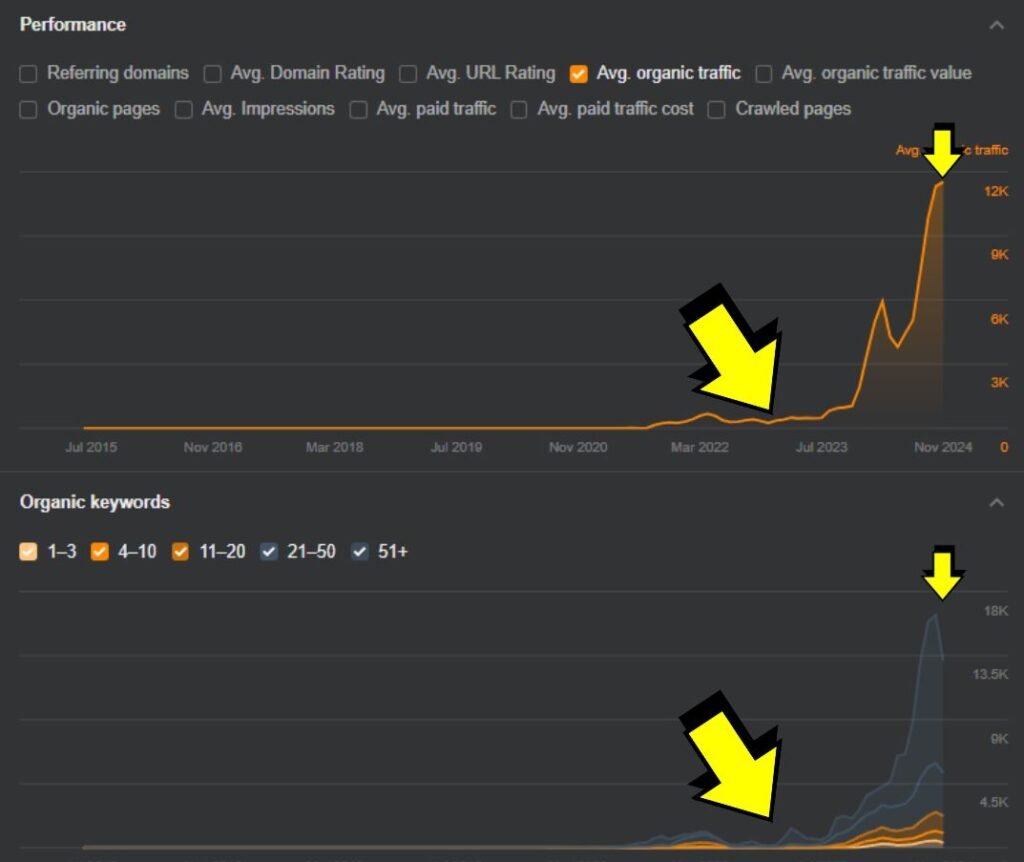
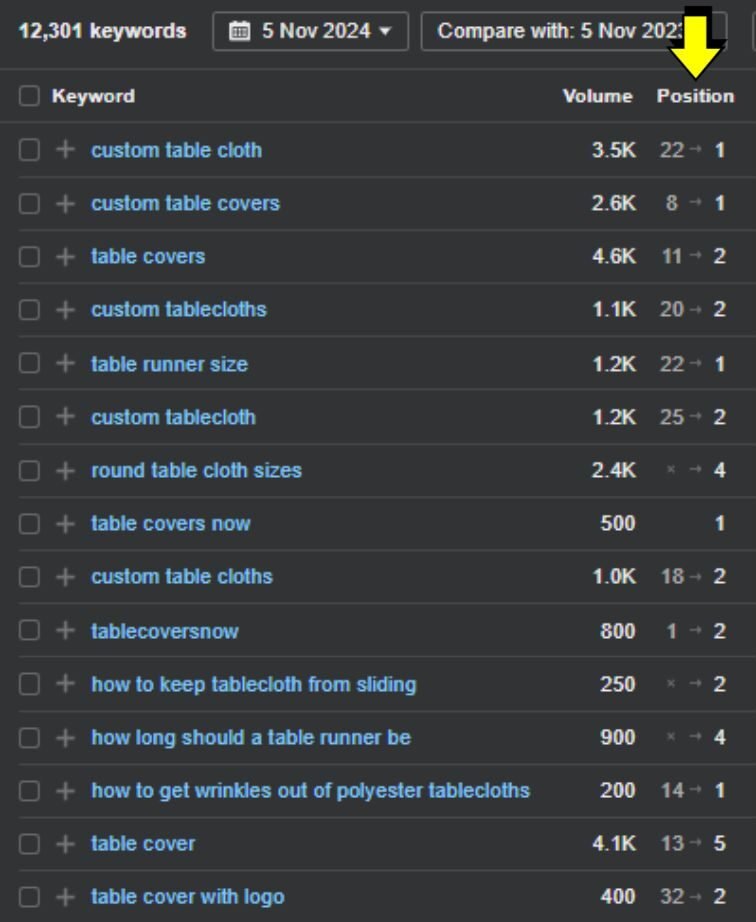

CUSTOM PATCHES ECOMMERCE
A specialized e-commerce brand in custom patches set out to increase sales and capture more search visibility in the customizable product space. The goal was not just to rank for terms like “custom patches” but also to target specific needs and designs that potential buyers were searching for.
We conducted a comprehensive keyword and market analysis, resulting in over 14,000 keyword clusters. This enabled the creation of SEO-optimized pages tailored to both informational and transactional intents. Each blog and product page linked seamlessly, driving traffic and boosting conversions.
The results have been exceptional: the client’s site now ranks at the top for major keywords, with monthly traffic growing from 300 to over 12,000, bringing in customers ready to buy.
Before
Start: Feb 23
Traffic: 381
Keywords: 20
After
End: Working
Traffic: 17K
Keywords: 17K
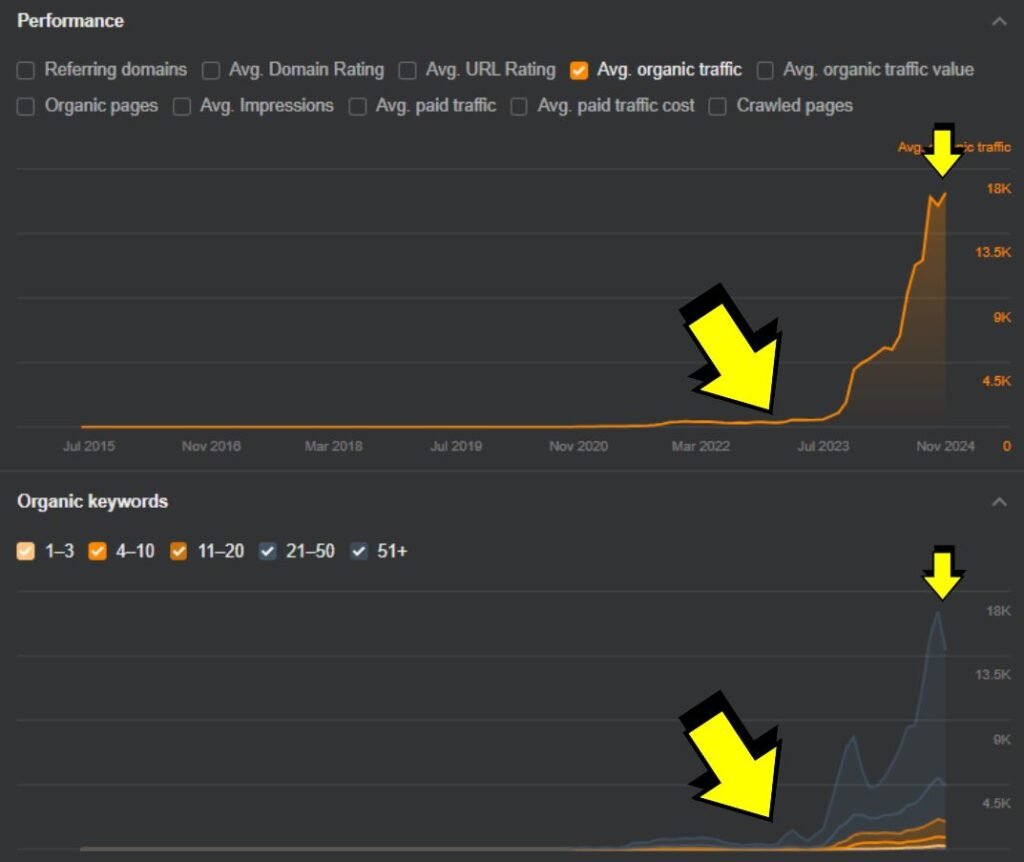
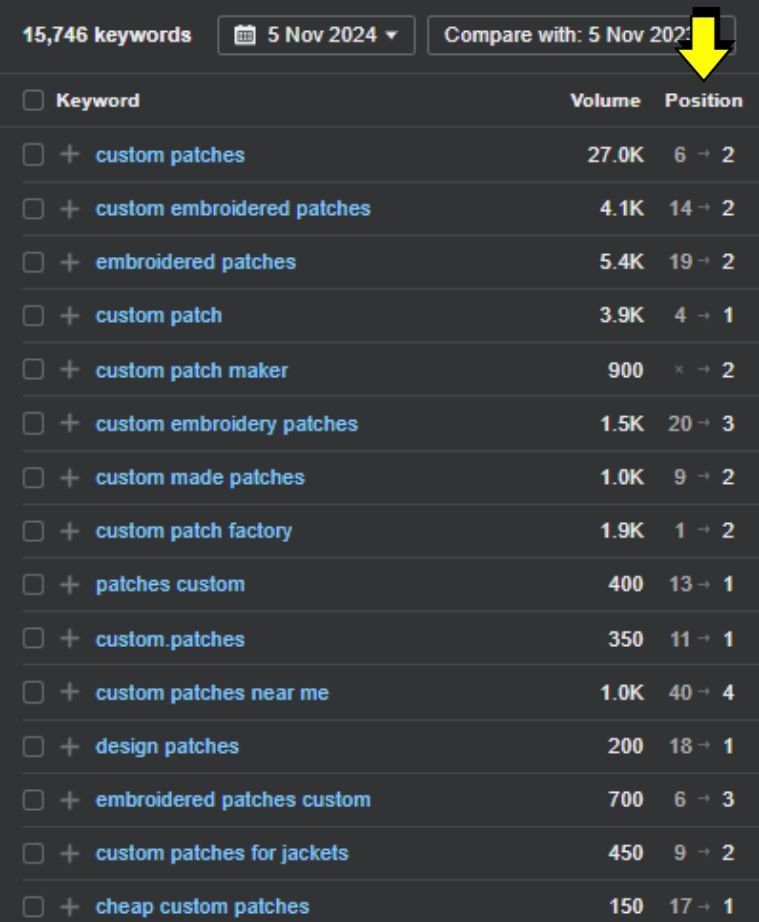

INTERNATIONAL FOOTBALL ACADEMY
An ambitious project to help players all over the world find a club in Spain.
A full-on website redesign and SEO strategy to attract potential clients in all the steps in their journey.
The strategy has been so succesful that they have had to hire more coaches and a head of academy and the owner had not intented to have such a big football academy.
Before
Start: Feb 19
Traffic: 0
Keywords: 0
After
End: Sep 23
Traffic: 9K
Keywords: 2K
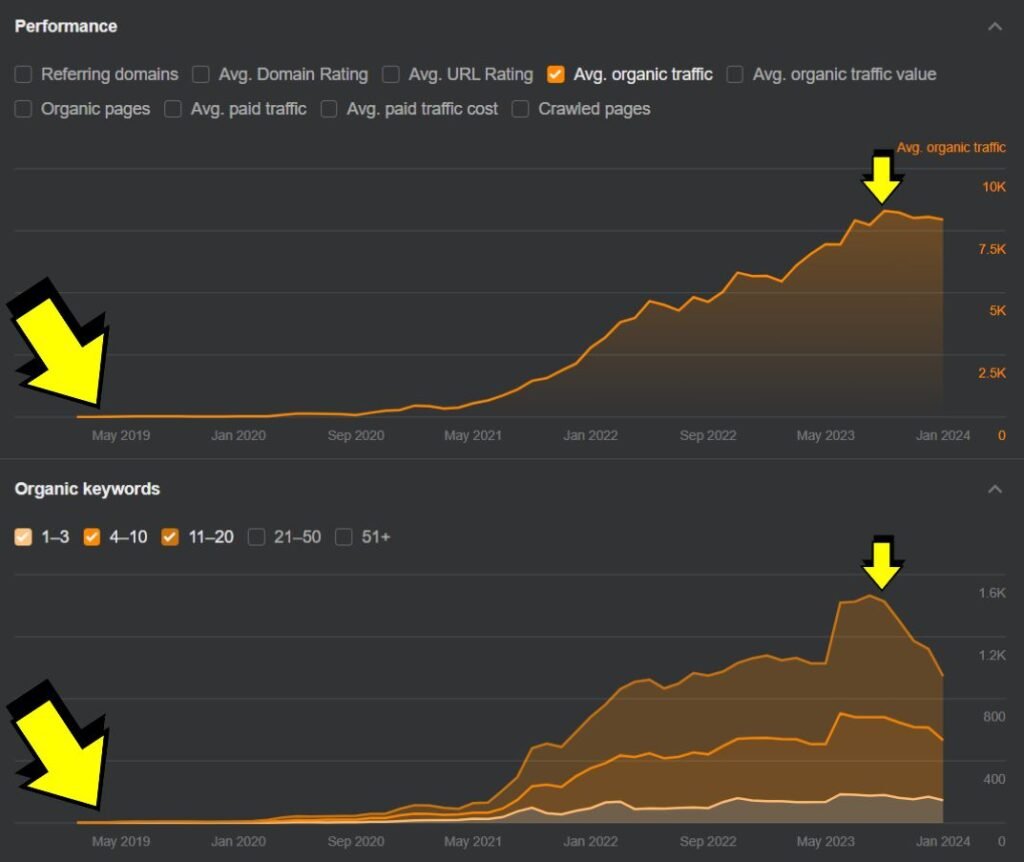


REAL ESTATE GIANT IN THE US
A prominent real estate enterprise focusing on the Indiana market, often compared to a local Zillow, sought to strengthen their online presence and capture more targeted traffic. With an expansive database of listings, they needed an SEO strategy that aligned with how potential buyers search for homes.
We implemented a precise SEO approach, creating transactional pages optimized for location, price, and property type, while also establishing a robust internal linking structure. Dynamic content was incorporated to keep pages relevant and personalized to local market data.
The results were transformative—keywords that previously didn’t rank now occupy top positions, driving thousands of monthly clicks and positioning the client as a market leader in Indiana real estate.
Before
Start: Feb 23
Traffic: 20K
Keywords: 90K
After
End: Working
Traffic: 40K
Keywords: 92K

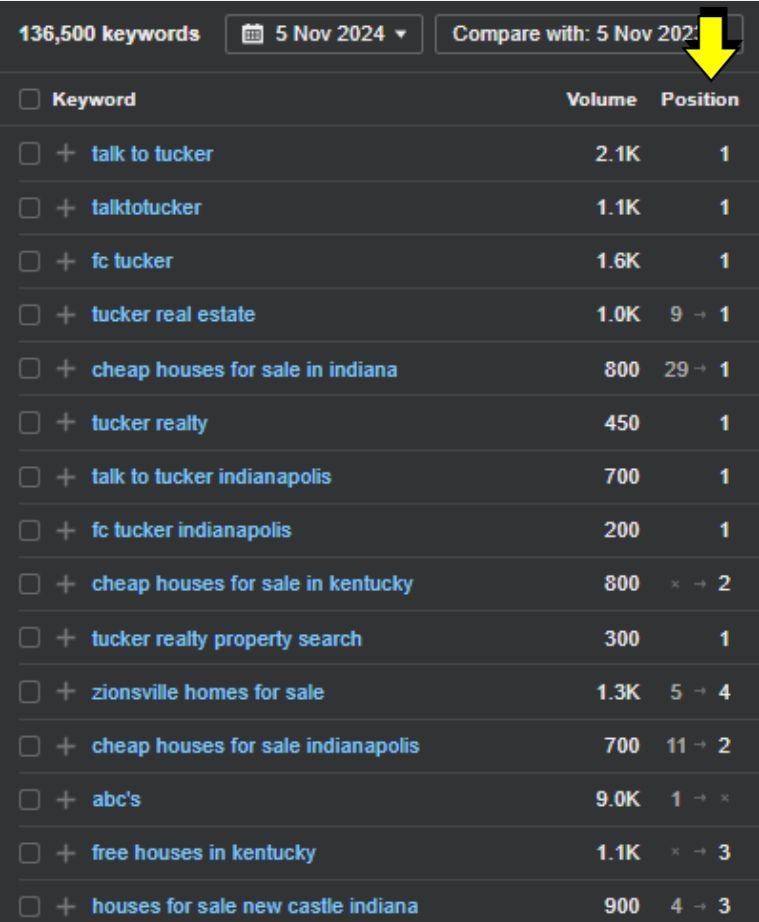
FAMILY OWNED RENT A CAR
A well known and established family rent a car in the area. Their goal is to reach an international audience in Google and transmit the close and friendly treatment that characterises them.
A full on SEO strategy to multiply the number of pages attacking valuable keywords in Google. A big focus on location based keywords and improving all of our pages to answer the intention of the user searching better than our giant competitors.
The strategy has been so succesful that they had to purchase a bigger fleet of vehicle to meet the client’s demand.
Before
Start: Aug 21
Traffic: 141
Keywords: 110
After
End: May 22
Traffic: 4K
Keywords: 513
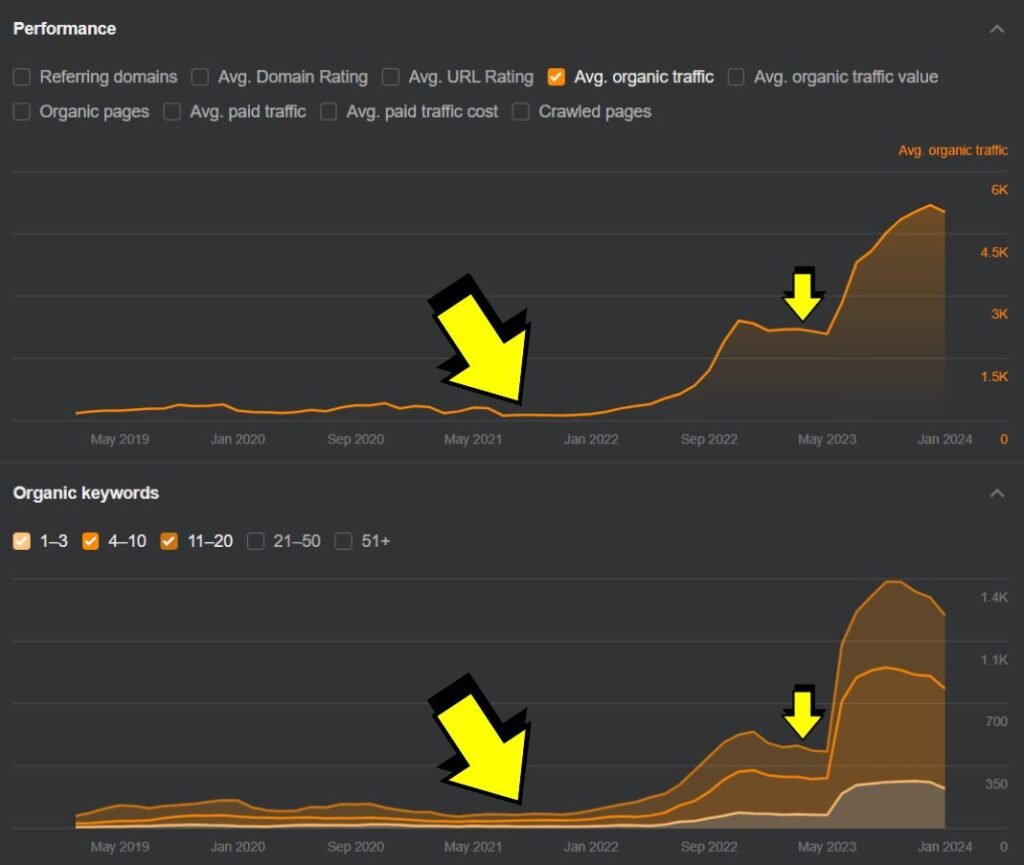


FAMOUS FOOTBALL MAGAZINE
An established football brand specialised in youth football. They wanted to increase the amount of traffic from Google to reach their target audience.
A complete new CRO and UX minded website redesign and a migration from Wix to Wordpress. Added to this strong base, a full on monthly SEO strategy to target new potential clients in Google.
The strategy has been so succesful that they have changed their business model from selling magazines to adding ads in their website to monetize the huge acquired traffic.
Before
Start: Sept 21
Traffic: 5K
Keywords: 2K
After
End: Oct 22
Traffic: 40K
Keywords: 5K



RENOWED FOREX PROPRIETARY FIRM
A famous Forex propriertary firm in the center of the City of London that wants to increase signs ups in their funded program and regain market share for their competitors.
A full, search intent driven, SEO strategy focusing on ranking transactional pages and informative guides to convince trading talent to trade with the company’s funds.
This project has so much growth oportunity and plans of action that I really had to plan correctly to manage the resources efficiently. The sector is extremely competitive in terms of SEO.
Before
Start: Aug 21
Traffic: 735
Keywords: 67
After
End: Oct 22
Traffic: 11K
Keywords: 3K
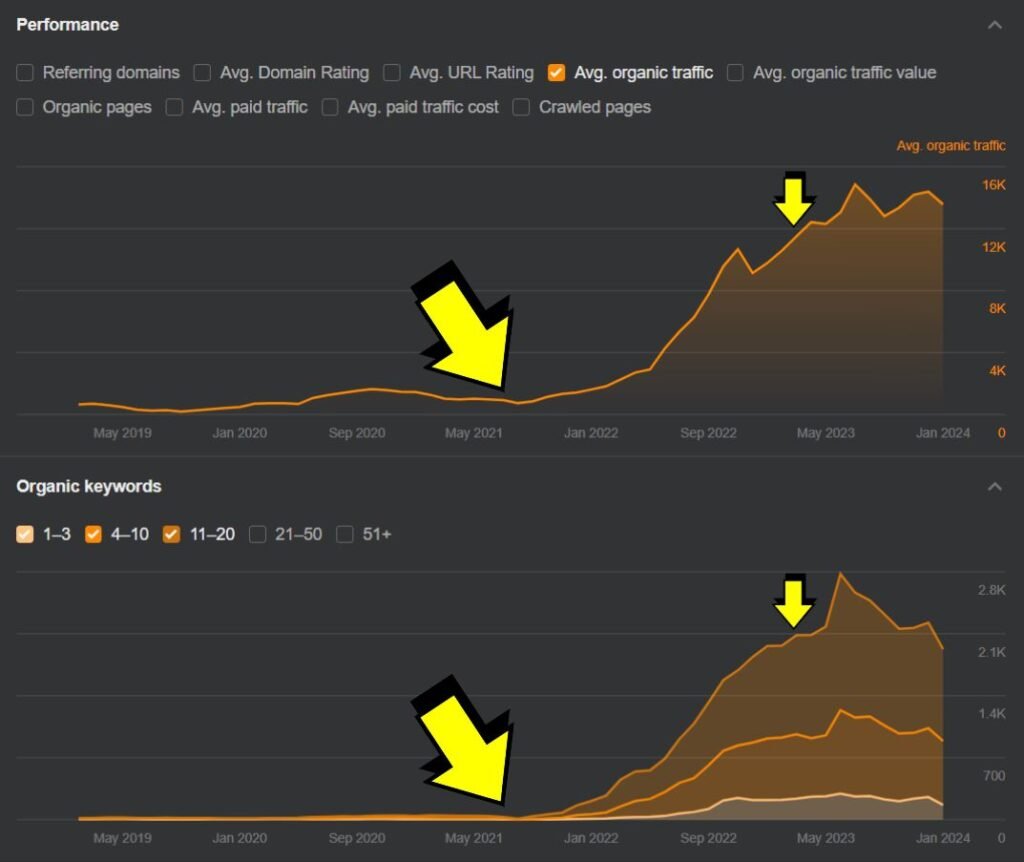
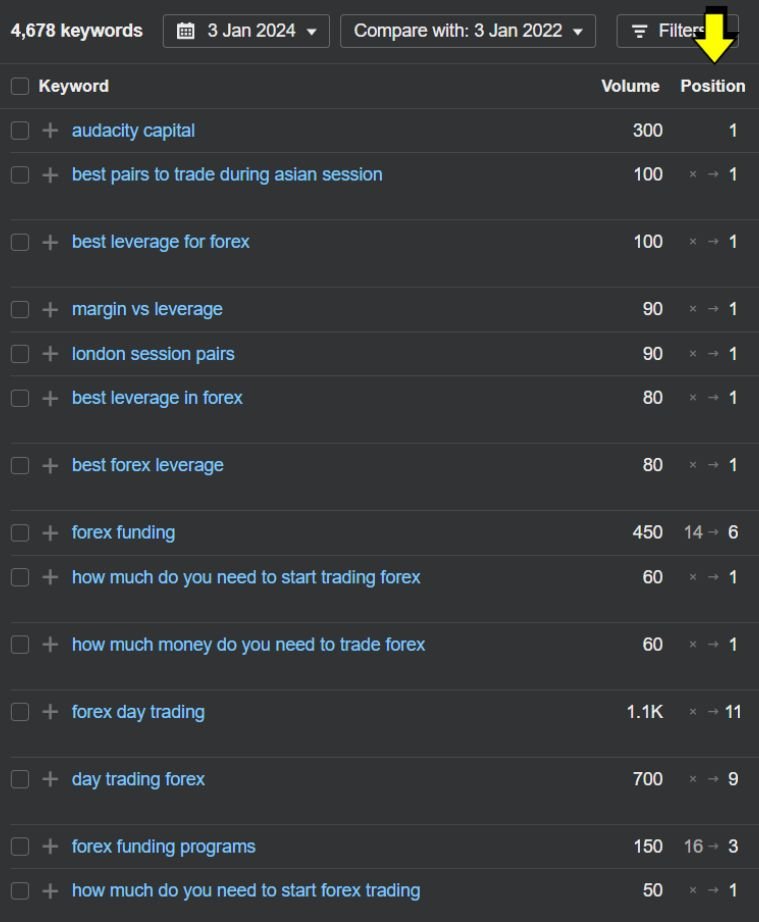

SCHOOL FOR FOOTBALL COACHES
A popular Spanish academy for football coaches to get their licenses that wanted to increase leads in all their courses as well as gain exposure in the top-of-funnel searches of their potential clients.
The client had enough variations in their services to create a full SEO strategy focused on making many landing variations that answer very specific user search intentions.
The strategy has been so succesful that they’ve had to open more schools in different areas of Spain to increase revenue and growth.
Before
Start: Aug 21
Traffic: 381
Keywords: 68
After
End: Jul 22
Traffic: 802
Keywords: 253
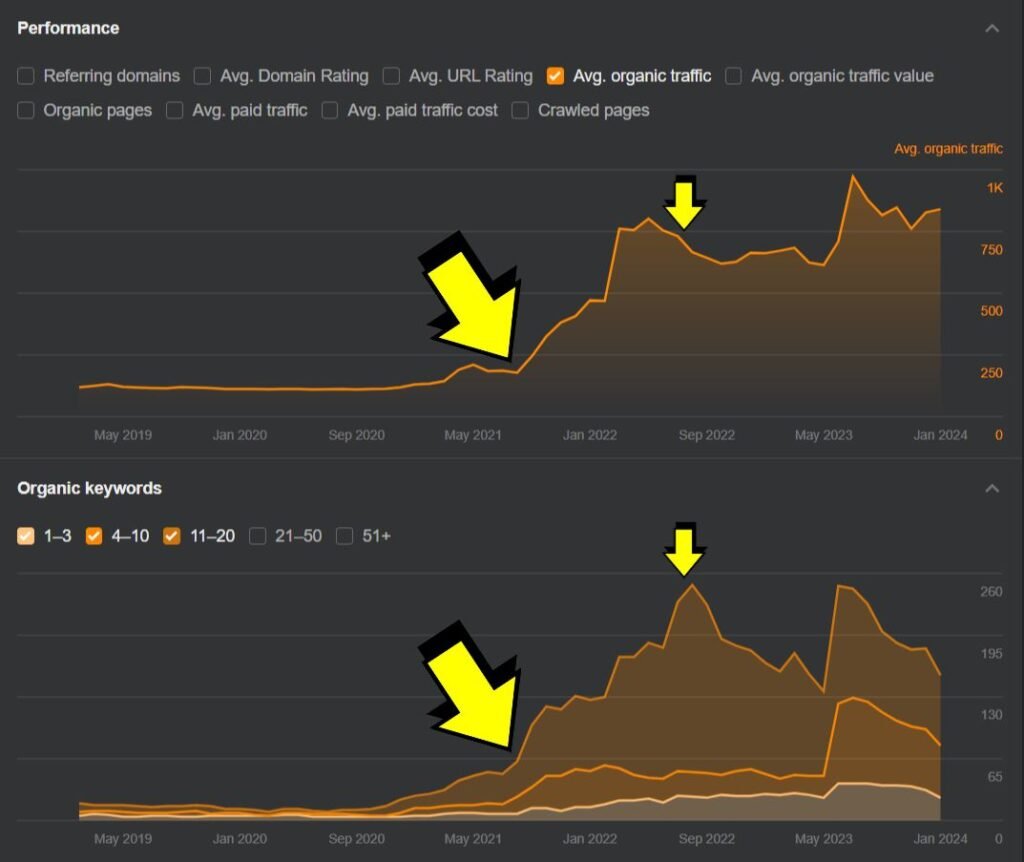

CUSTOM COASTERS ECOMMERCE
An e-commerce brand specializing in customizable coasters sought to increase sales and visibility for top keywords like “custom coasters.” Surprisingly, this niche had significant demand, prompting a deep dive into keyword and market research to identify buyer personas and their unique needs.
We structured a robust SEO strategy, building transactional and informational pages targeting everything from customizable options to gift ideas for home bars and mini bars. Optimized templates ensured that each page could convert visitors seamlessly.
The results have been impressive: traffic grew from 300 to over 11,000 monthly visitors, with the homepage now ranking #1 for highly competitive terms like “custom coasters,” positioning the client as a leader in the market.
Before
Start: Feb 23
Traffic: 0
Keywords: 5
After
End: Working
Traffic: 14K
Keywords: 3K
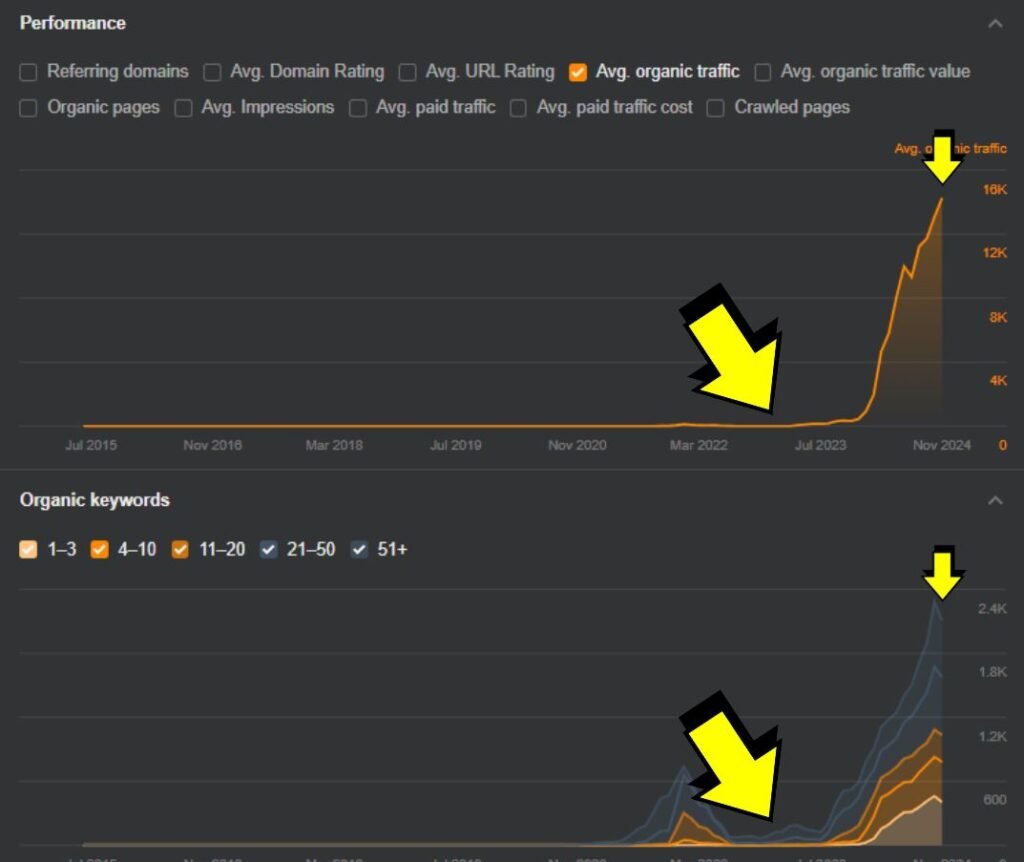
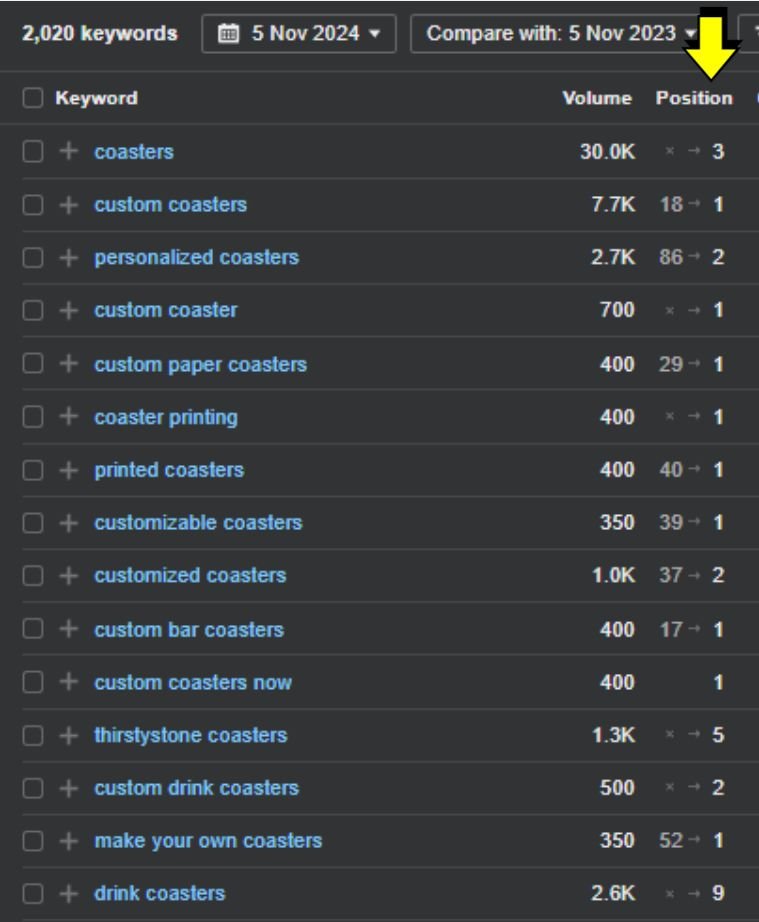

CUSTOM NEON ECOMMERCE
An e-commerce brand specializing in custom neon signs entered a competitive market with the goal of boosting visibility and capturing high-intent buyers. Given the high competition in this profitable niche, we conducted thorough market and keyword research, identifying buyer needs and clustering over 8,000 keywords to guide content strategy.
We developed SEO-optimized pages targeting both informational and transactional searches. The strategy included unique angles like targeting neon signs by quotes, colors, and events, as well as crafting specific designs for different customer intents.
The results have been significant, with traffic growing from zero to over 2,000 monthly visitors, and with the higher profit per sale, the return on investment has been highly promising.
Before
Start: Feb 23
Traffic: 336
Keywords: 183
After
End: Working
Traffic: 3K
Keywords: 6K
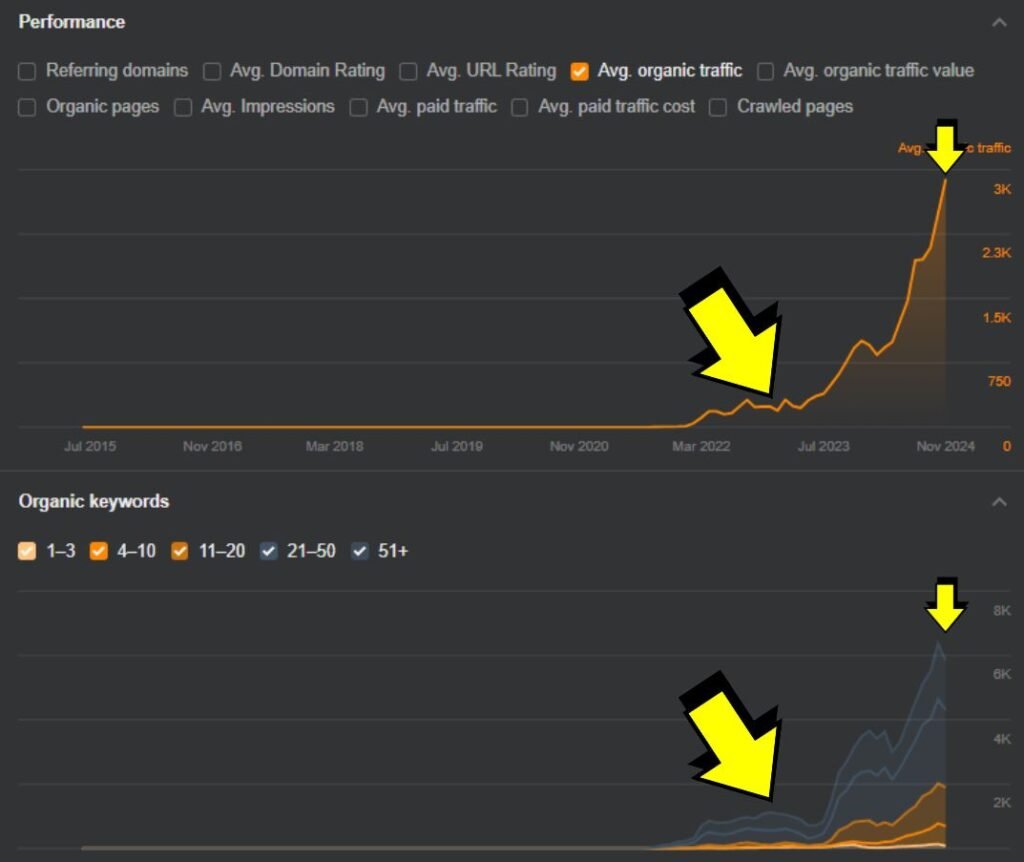
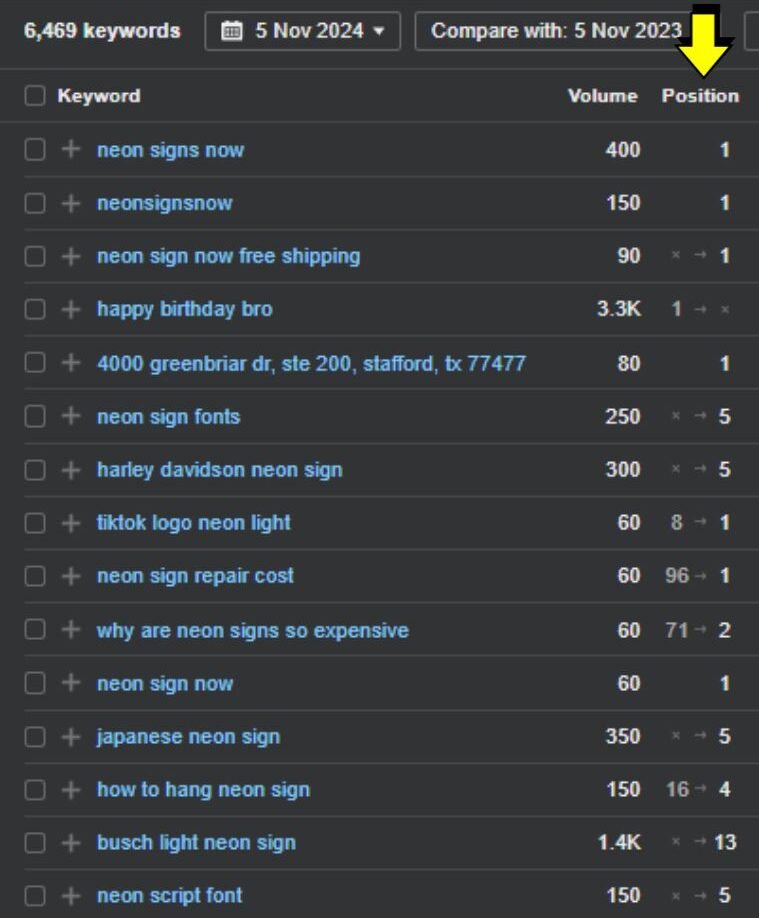

REAL ESTATE AGENCY FOR INVESTORS
Texas-based real estate agency focused on services for investors sought to boost visibility in a highly competitive market. Targeting investor-specific keywords in Texas, we recognized early on that competing with major national real estate sites would require a tailored approach.
We built a comprehensive SEO strategy that targeted hyper-local areas, neighborhoods, and investment-centric searches, like “investment properties” and “Airbnbs for sale” in specific Texas locations. By leveraging these niches, we were able to maximize relevance for Texas investors without competing directly with broad national keywords.
The results have been substantial, with the site growing from zero to over 2,000 monthly visitors, attracting highly qualified, investment-focused leads.
Before
Start: Sep 22
Traffic: 0
Keywords: 0
After
End: Working
Traffic: 4K
Keywords: 7K
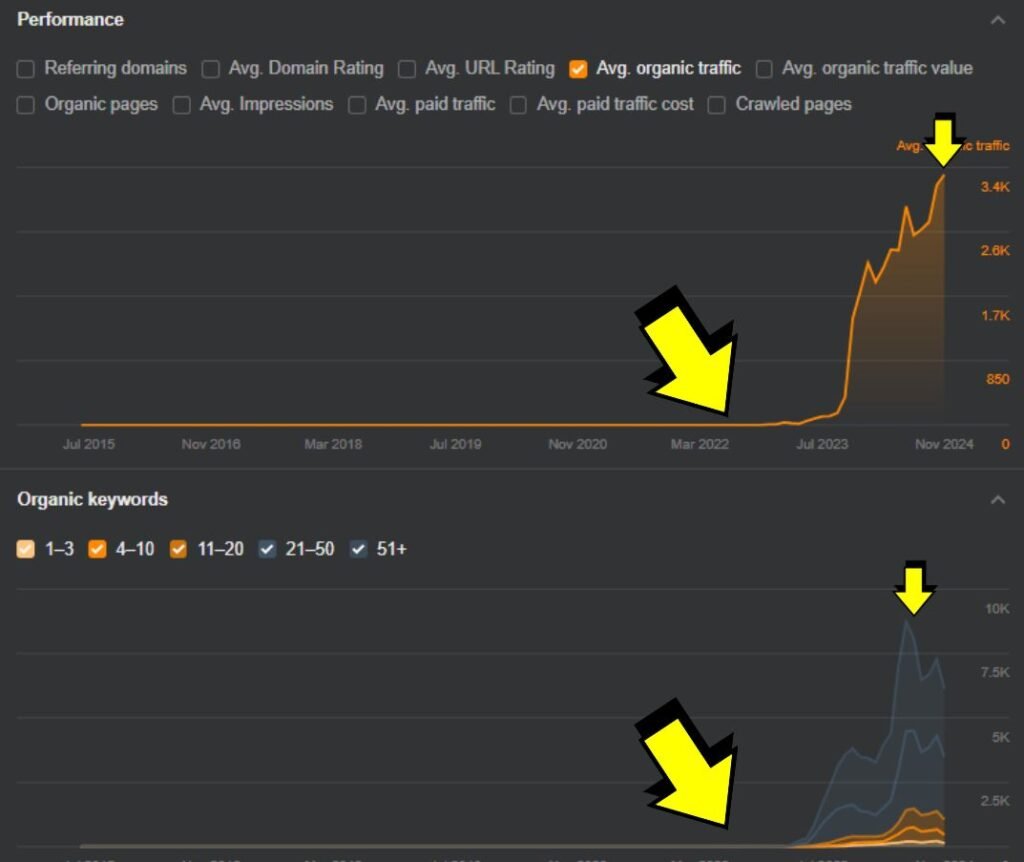
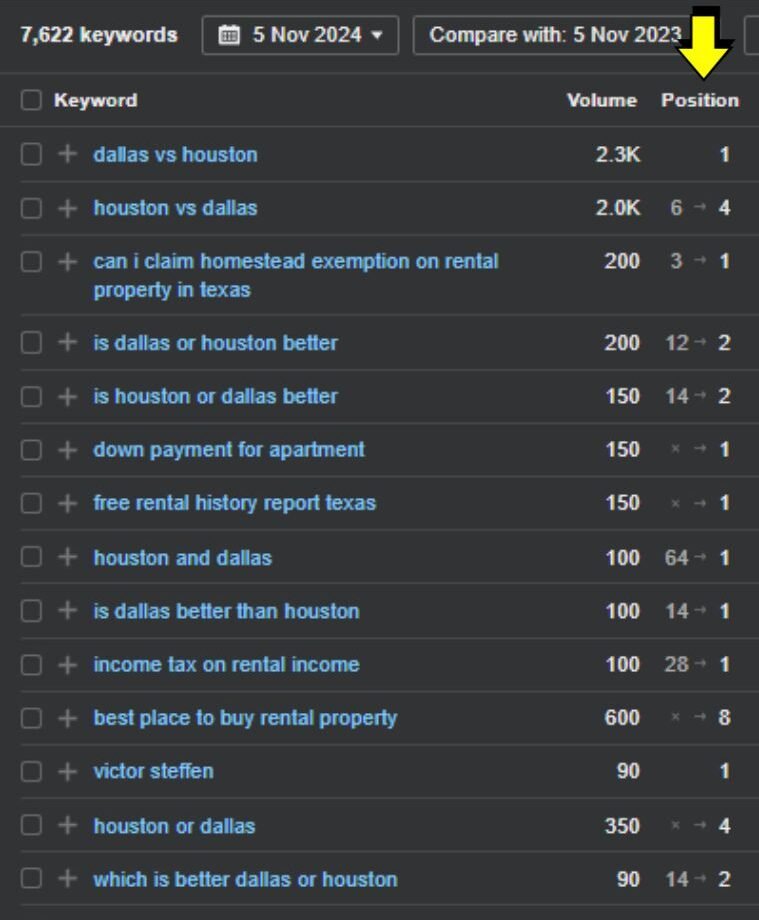

LOCAL REAL ESTATE AGENCY IN CALIFORNIA
A real estate agency specialised in working with people local to the California area, so these individuals can acquire a property in in this highly demanded area.
Before
Start: Dec 22
Traffic: 77
Keywords: 22
After
End: Working
Traffic: 9K
Keywords: 13K
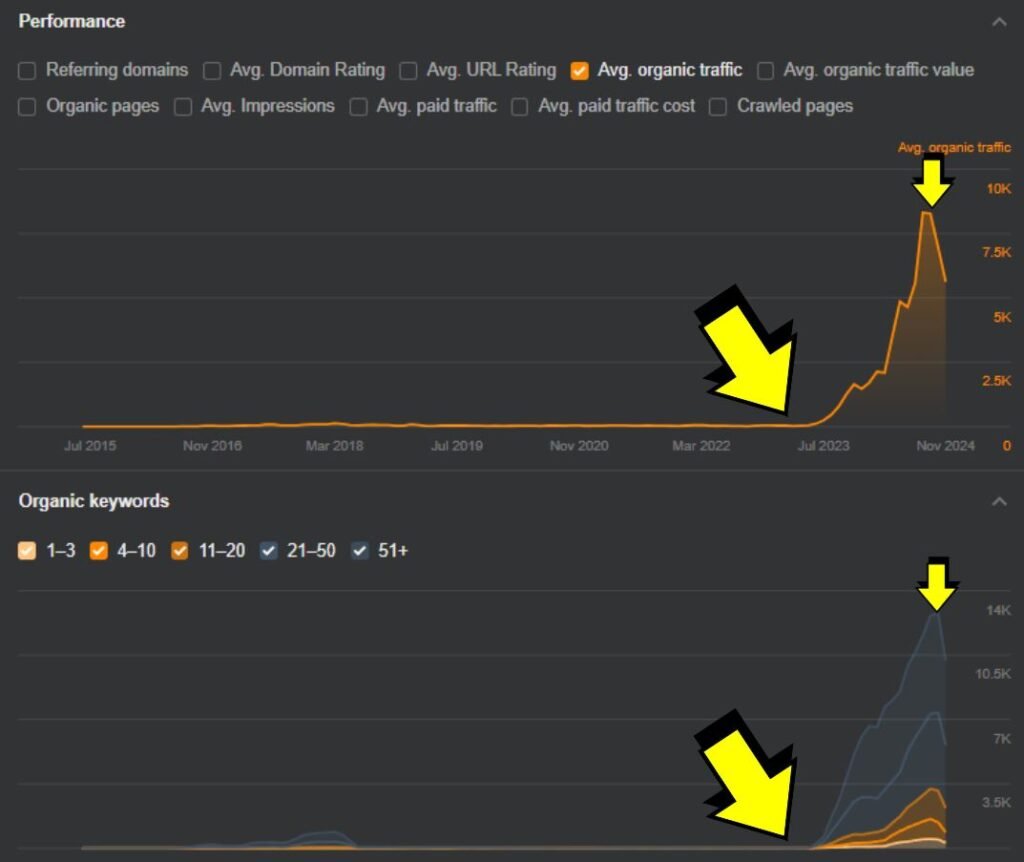
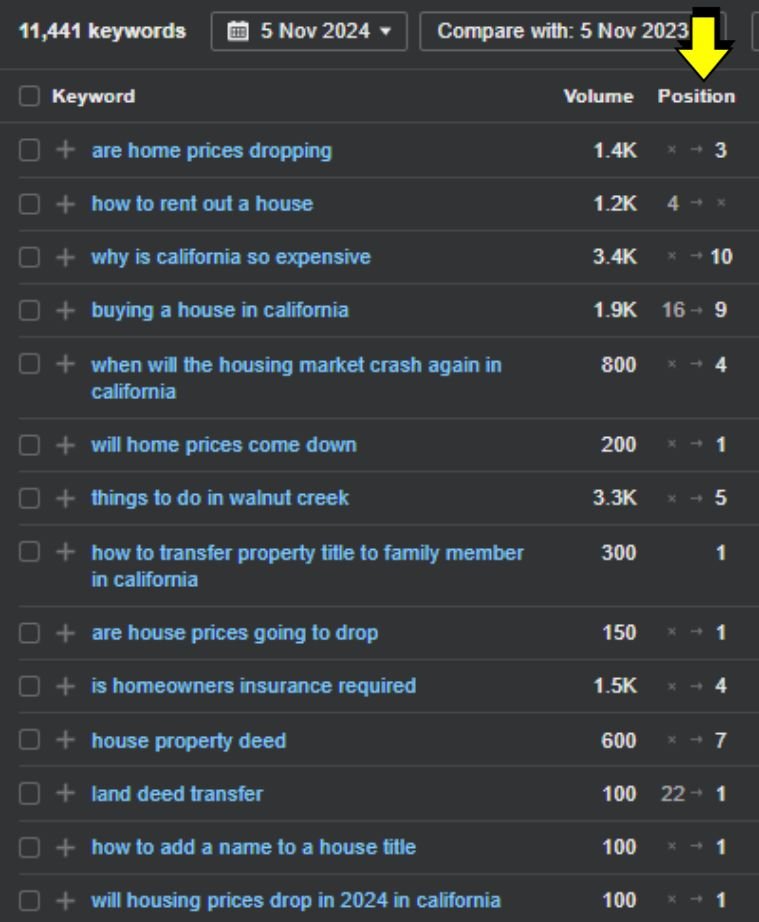

ORGANIC COFFEE ECOMMERCE
An e-commerce brand selling specialty coffee and coffee beans aimed to carve out its place in the crowded coffee market. Given the immense competition and the client’s smaller SEO plan, we focused on high-impact, niche-specific opportunities rather than broad, high-traffic terms.
Our strategy centered on detailed keyword analysis and filtering, targeting keywords directly related to the client’s offerings, like cold brew and coffee subscriptions. We optimized each blog and product page with SEO and conversion elements to ensure the best results.
In just four months, the site’s traffic soared from a few hundred to over 5,000 monthly visitors, capturing a strong foothold in the specialty coffee market with prominent featured snippets.
Before
Start: May 23
Traffic: 31
Keywords: 64
After
End: Jan 24
Traffic: 5K
Keywords: 1K
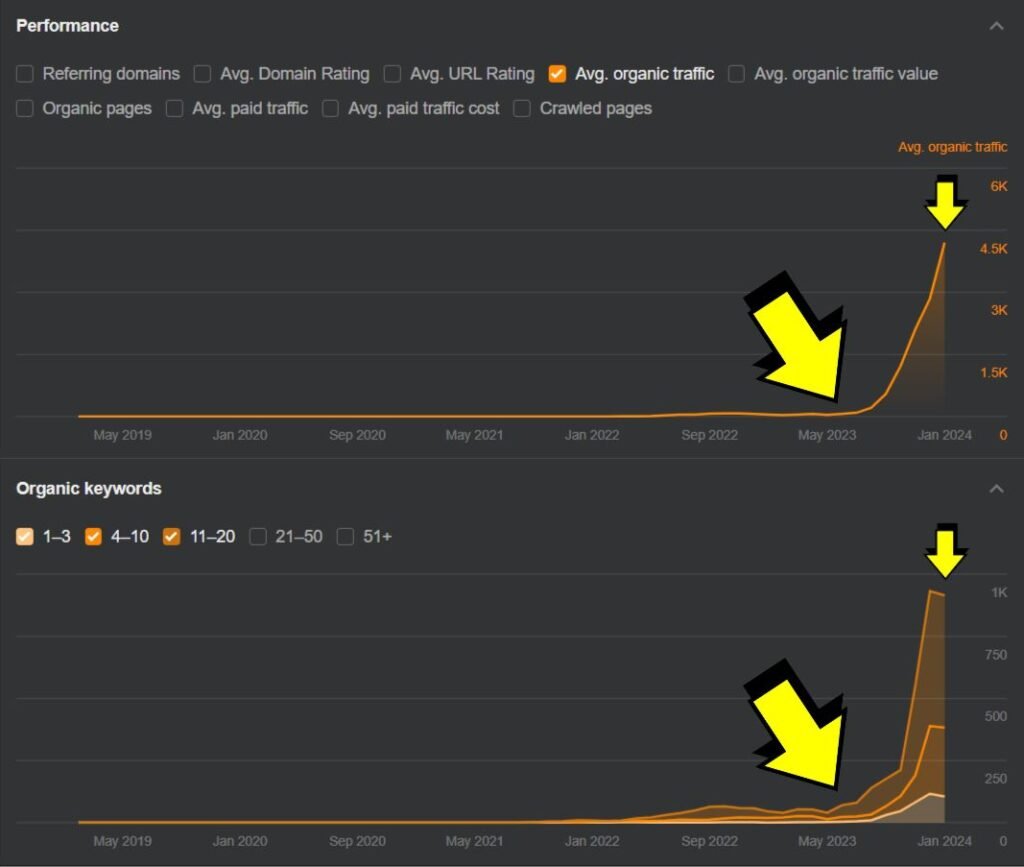
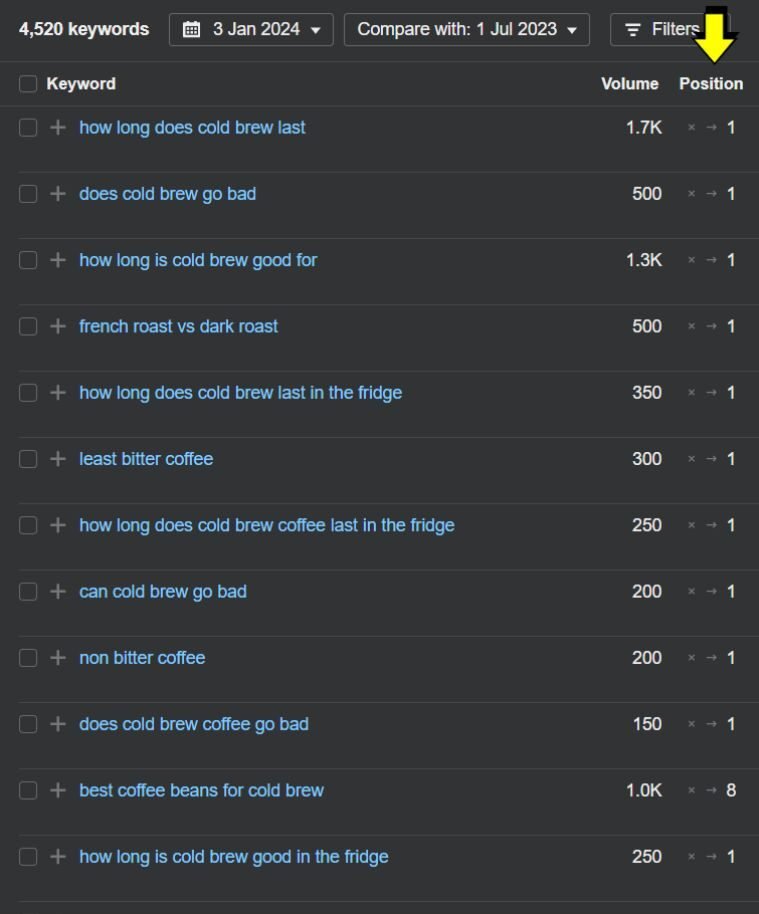

ENTERPRISE INVENTORY SOFTWARE
A niche software client specializing in inventory solutions for large enterprises sought to improve SEO visibility, with a focus on transactional pages targeting specific industries and functions.
To build an effective strategy, we ran an extensive keyword and competitor analysis, uncovering over 44,000 potential keywords. We segmented these into highly targeted clusters, prioritizing transactional pages for industry-specific terms like “inventory management for universities” and “asset management solutions.” Each landing page was meticulously optimized to attract conversions, with CTA placements, tailored schema markup, and a clear site structure.
This approach yielded impressive results, taking the site from 300 to over 1,000 monthly visitors in the English market alone, with success replicated across translated pages in Spanish and German.
Before
Start: Nov 23
Traffic: 1K
Keywords: 2K
After
End: Jul 24
Traffic: 4K
Keywords: 7K
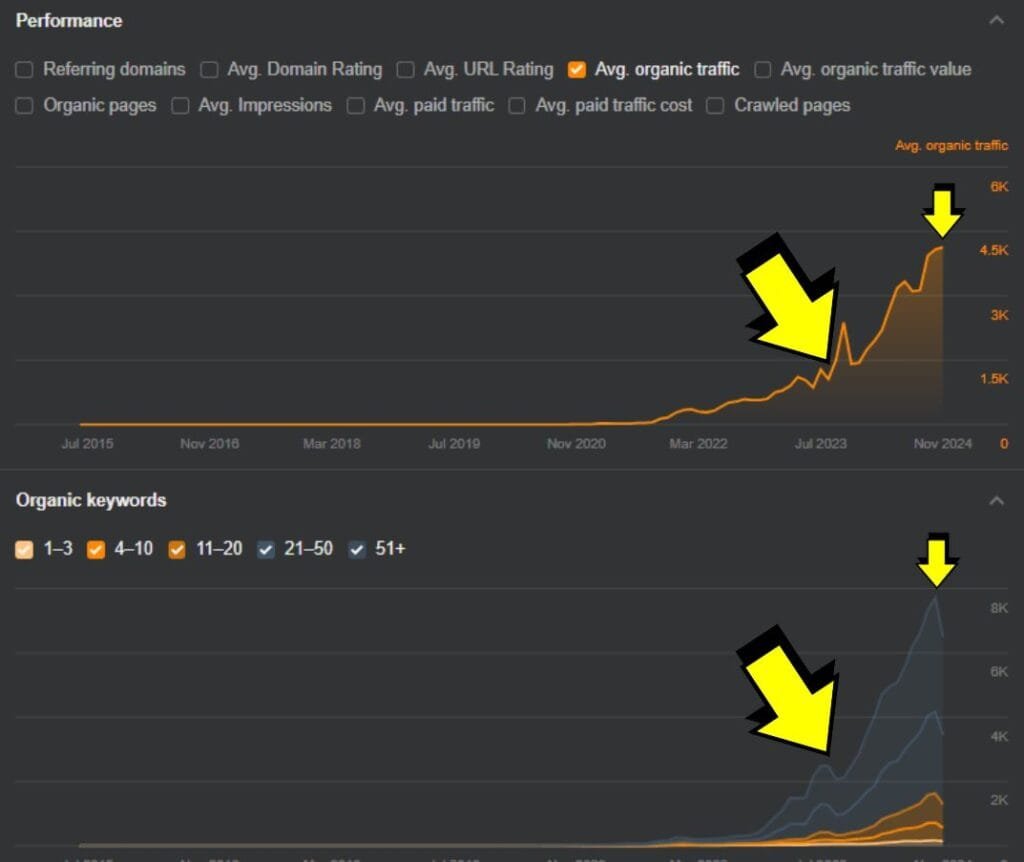
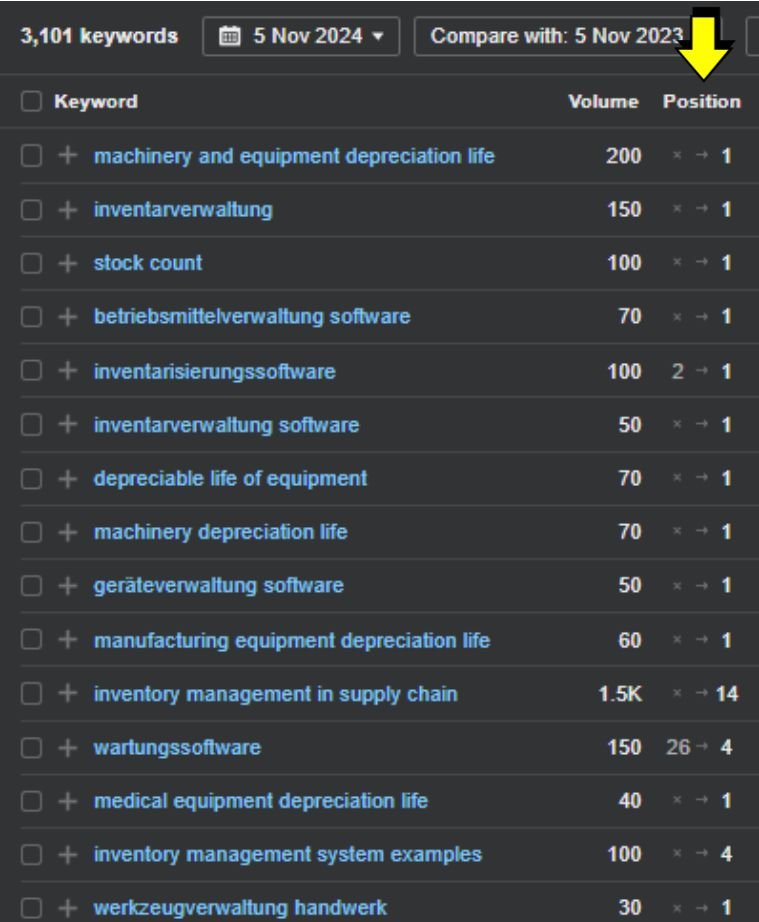
NORWEGIAN ONLINE SCHOOL
An online language school specializing in Norwegian had already gained significant traction through social media but sought to expand its reach through SEO. We kicked off the project with comprehensive keyword research and competitor analysis, focusing on both informational and transactional search terms.
We built a detailed website architecture, creating topic clusters on areas like vocabulary and pronunciation. Transactional pages targeted specific needs, such as courses by level and specialized courses for immigrants, all optimized to convert visitors into students.
The results were transformative: from zero online visibility, the site now ranks for top keywords, including featured snippets, driving one thousand of targeted visitors each month.
Before
Start: Nov 22
Traffic: 0
Keywords: 0
After
End: Dec 23
Traffic: 1K
Keywords: 232



TRAVEL AGENCY FOR CARIBBEAN HOLIDAYS
A travel agency specializing in trips to two exclusive South American resorts sought to increase online visibility and attract high-intent travelers. Given the niche focus, our strategy honed in on highly specific keywords directly relevant to the resorts to maximize return on investment.
Through careful keyword clustering, we targeted both informational and transactional searches, creating optimized pages on topics like resort deals, top experiences, and even timely content like hurricane policies when relevant. Each page was crafted to convert, with strategically placed calls-to-action to drive bookings.
The approach has paid off, boosting the site’s rankings and attracting a growing number of engaged visitors, with critical pages like “best Sandals resorts” and specific deal pages climbing to top positions in search results.
Before
Start: Nov 23
Traffic: 544
Keywords: 3K
After
End: Working
Traffic: 4K
Keywords: 7K
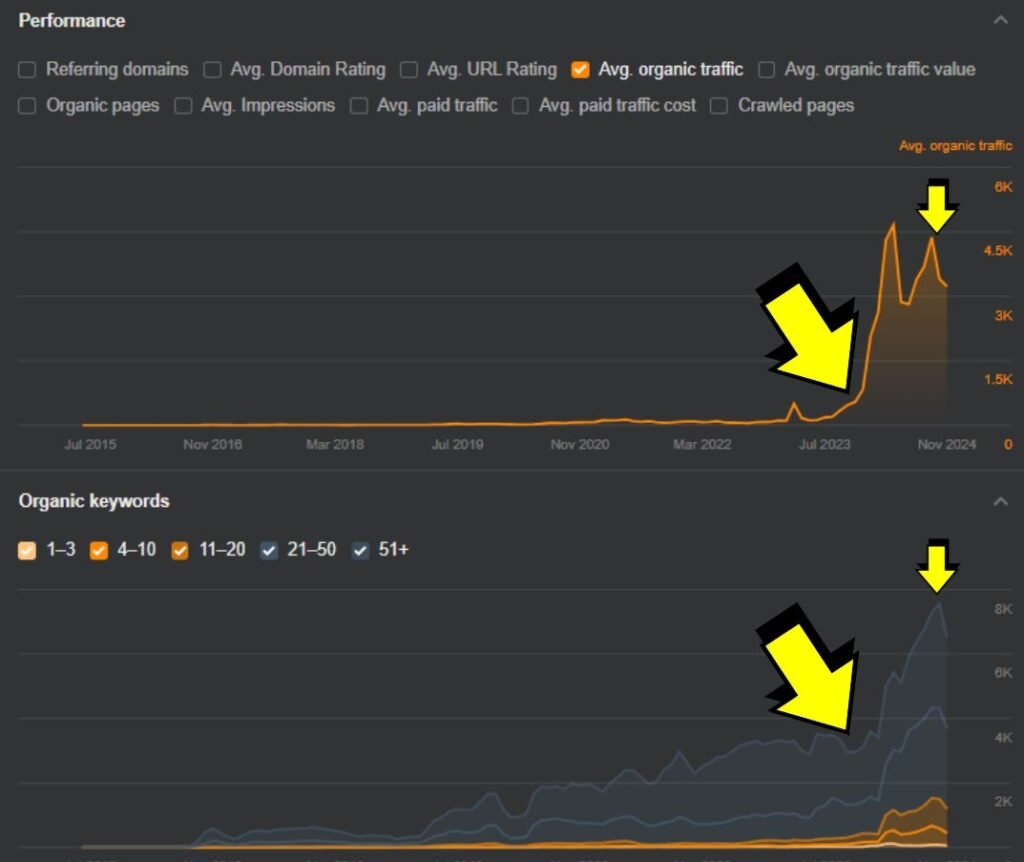
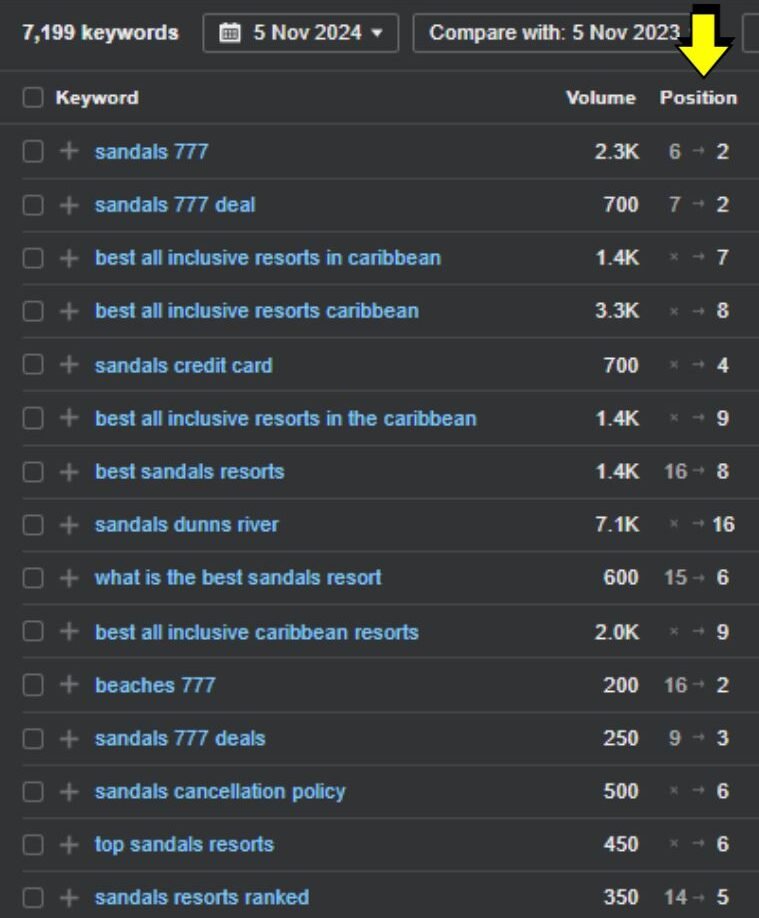

FLORIDA REAL ESTATE INVESTOR AGENCY
A Florida-based real estate agency focused on investor clients sought our SEO expertise. Having worked with a similar Texas client, we skipped initial research and applied a tested strategy tailored to Florida. We created SEO-optimized pages on topics like “investment properties in Florida,” including Florida-specific elements.
Our approach yielded rapid results, boosting rankings for competitive terms. With optimized H1s, internal links, and targeted CTAs, the client’s site secured top-five rankings, even appearing for national searches. By reusing successful content from Texas, we accelerated traffic growth.
Traffic quickly jumped from zero to nearly 300 monthly visitors. Although the client paused services later, this project demonstrated the value of adapting a proven strategy for quick success.

E-COMMERCE VAPE STORE
An e-commerce client specializing in vapes approached us to improve search visibility in a highly regulated industry. Given Google’s extra caution with vape-related content, we developed a strategy tailored to their unique challenges.
Starting with an in-depth keyword and competitor analysis, we identified over 56,000 potential pages, prioritizing high-value transactional pages to bring in sales quickly. We also optimized each product, category, and blog page for SEO, integrating new templates and internal linking to boost authority and ranking potential across the site.
The result? Immediate traffic increases for newly optimized pages, climbing to over 4,000 monthly visits in just a few months, even within a heavily regulated sector.

REAL ESTATE AGENCY FOR FOREIGNERS
A Dutch estate agency in Spain that wants to attract foreign possible buyers and gain exposure when their searching for information before buying.
A lot of International SEO and work with the Blog to attract potential clients in the ‘Interest’ step.
In addition, a complete new SEO full on strategy in their new website to attract customers in their ‘Buying’ step and to smartly get a ‘piece of the cake’ from the huge market of housing portals in the top Google positions.
Before
Start: Feb 19
Traffic: 451
Keywords: 129
After
End: Mar 22
Traffic: 9K
Keywords: 13K
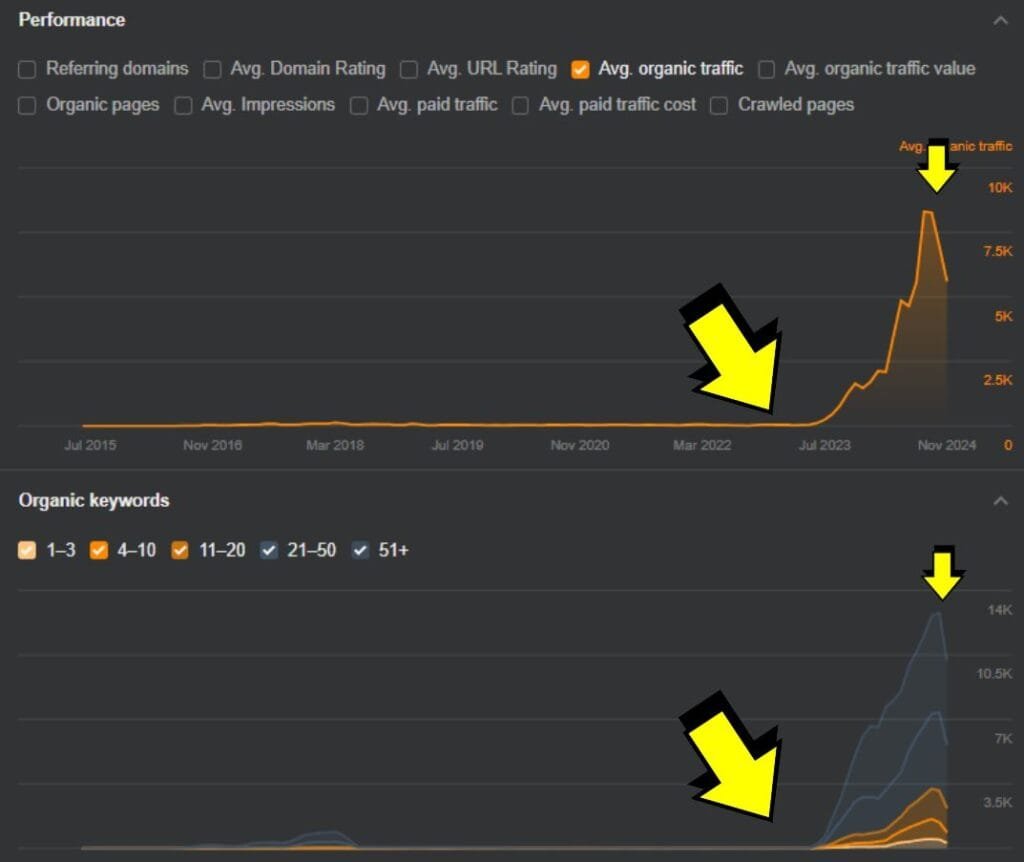
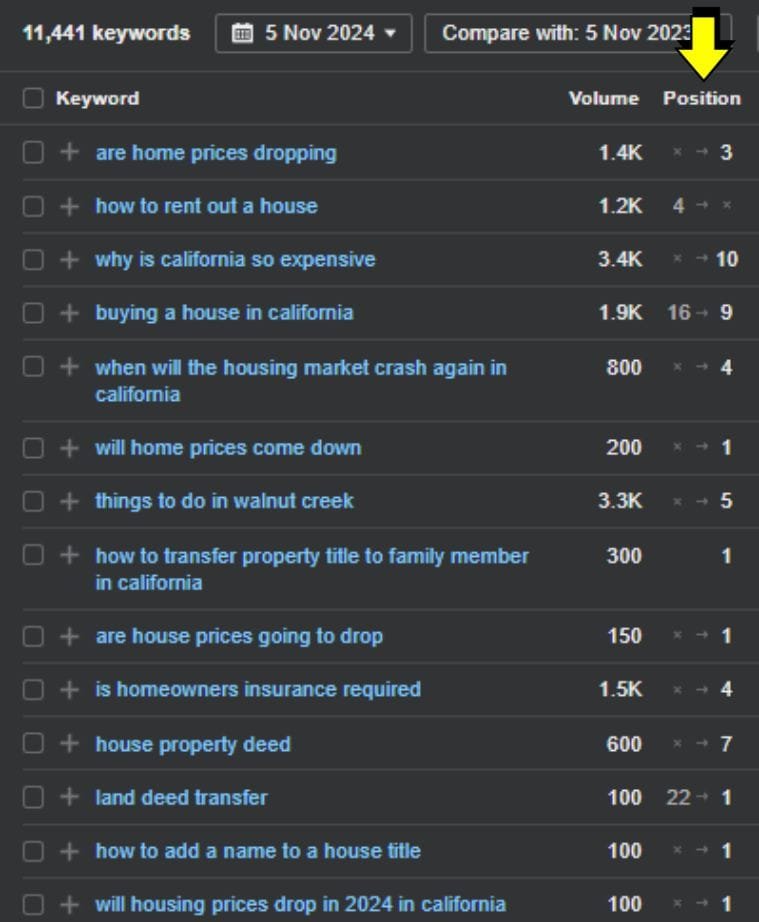

COLLAGEN SUPPLEMENTS
A family owned business selling collagen and several other health related suplements.
Before
Start: Nov 22
Traffic: 4,260
Keywords: 527
After
End: Jul 23
Traffic: 10K
Keywords: 2K
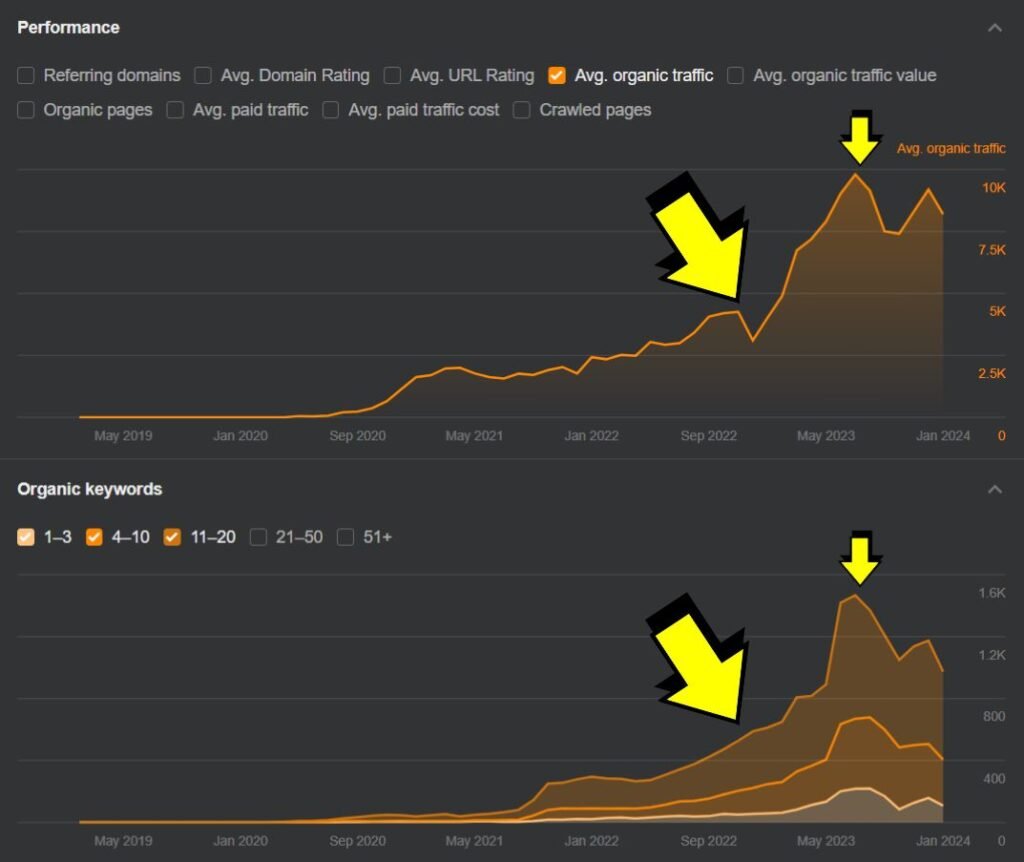

YEARS OF FREQUENTLY ASKED QUESTIONS, ALL IN ONE PLACE
Over 50 FAQs answered
Over the years I have heard great questions related to SEO and my services, so I’ve grouped the most relevant ones into pshychological pain points you migth feel right now, and I’ve given the most informative answer possible so you can understand it right away:
- I’m worried that SEO can not bring business results
- I don’t think my business or website is ready to start doing SEO
- I don’t want SEO to affect my current business results or website negatively
- I’m not sure if SEO can blend with my other marketing efforts
- I’m not sure if SEO can blend with my other marketing efforts
- I’m worried about how hard it will be to adapt you and your SEO strategy with my current team
I'm worried that SEO can not bring business results
I will show you as many examples are you need, sharing the screen with the real Google Search Console and Google Analytics dashboards, of clients that I have worked with for years with proven SEO results and an overview of how we get them.
Point being, the ultimate proof is to ‘show it’ and not to ‘speak it’. I am the most skeptical person when trusting people, and extremely safe, when investing and doing business. What I would want is to see real results and proof of how they were achieved.
Do consider that ‘looking at the past’ does not assure that the same will hapen with you, however is the closest thing to predicting it that we can do (that is not seeing the future haha). You can trust that results will come because my approach is based on data, proven methods, and years of experience. I’m not guessing—I analyze your market, your competitors, and your website to create a strategy that’s customized to your business.
As well as using our brain and AI, to come up with the best SEO strategies and actions to get results.
The question I get asked the most. As an skeptical person when trusting people and I have a safe mindset when investing myself, the logical thing to do would be to show the results of past client and focus on how long they took to come. So we can do that in our call.
However to provide a more clear answer, SEO results don’t come overnight, but it’s worth the wait. If we define SEO results as a significant growth in traffic, you’ll likely start seeing small improvements within 2 to 5 months, with more significant results around the 6 to 12-month mark.
The good news? Once we get momentum, it keeps building more and more. I always compare it to the compouding effect when investing consistelty in the stock market, where the amount of ‘results per unit of effort/investment’ drastically increases the more time goes on, as not only the pages you’re creating that month bring results, but also the past pages that you created bring even more results every month.
If we define SEO results as not just an increase in traffic, but getting more conversions and thus an increase in revenue for your business, logic tells us that it comes at a slight delayed frequency compared to traffic increase, because first the traffic increases, and only a % of that traffic converts, so you have to let the traffic and users coming interact with the website enough to be able to see a significant increase in this conversions/revenue.
The important thing is that, front the start, we focus on getting traffic that truly converts, by predicting who the people searching those keywords are and in what step of the buyer persona. For example with this client success story. the client told us that they saw better conversions with a specific buyer persona that was different to the initial one, so we shifted the strategy to focus on it right away. The absolute goal and our obsession is to bring you a ROI as soon as possible, making sure that every € you pay me turns into more €’s as soon as possible.
I also worked in an SEO agency in the past. Clients come in, you execute the ‘list of things’ you’ve been taught to do, with as minimal ‘brain power and resources’ as possible, and hppe that it works.
I get it—bad experiences with SEO agencies are common. What sets me apart is transparency. You’ll always know what’s being done, why, and how it’s driving results. I provide clear reports and proof of the work. No fluff, no vague promises—just data-driven strategies that you can track and understand. I also focus on business growth, not just traffic, so you’ll see measurable outcomes.
Added, as mentioned in my website initially: I would not really categorise working with me as having someone you pay to make specific SEO tasks and see if they work. But rather like having a brain behind your website, that makes strategic and data driven decisions to bring more potential clients that Convert. An extension of yourself and your team.
I will give the most complete, however also lean (simplified and easy to understand), report I can possibly provide as an SEO.
You can see an explanation of it here. It’s the same report I use to make my SEO decision and see how everything is going so it’s complete transparency. No lying, no biased to only show ‘the things’ that are working and hide the ones that are not.
From the website’s expoure (Google Search Console’s impressions) to the traffic (Google Search Console’s clicks) to the conversions (Google Anlytics 4 conversions), and everything in between. I’ll provide detailed reports that tie SEO efforts to real business metrics. You’ll be able to see how SEO is contributing to your goals, what strategies are working, what pages, what keywords, what actions, everything.
If if you want to see something else that isn’t in the report, we can just add it, easy!
The data I provide comes directly from trusted sources like Google Analytics, Google Search Console, and other industry-standard tools.
These platforms are transparent, and the numbers don’t lie. You’ll always have access to the same data I’m using, so you can verify everything for yourself.
It’s the same data you are using already before working with me, just industry standard stuff. So it can be trusted.
SEO is designed to connect your business with people actively searching for what you offer.
By targeting the right keywords and optimizing for the right audience, we don’t just bring traffic—we bring potential customers. Whether you want more leads, sales, or inquiries, the focus is on driving real, measurable growth that aligns with your business goals. The important thing is that, front the start, we focus on getting traffic that truly converts, by predicting who the people searching those keywords are and in what step of the buyer persona.
For example with this client success story, the client told us that they saw better conversions with a specific buyer persona that was different to the initial one, so we shifted the strategy to focus on it right away. The absolute goal and our obsession is to bring you a ROI as soon as possible, making sure that every € you pay me turns into more €’s as soon as possible.
We also actively adapt your website’s content and design to make sure it gets conversions like with this task.
You don’t have to be an SEO expert to see results. I break down everything in clear, simple terms, so you know what’s happening and why.
While SEO can seem technical, the outcome is straightforward—more traffic, more leads, and more business growth. I handle the complexity, and you see the benefits without needing to dive into the details.
SEO is designed to connect your business with people actively searching for what you offer. By targeting the right keywords and optimizing for the right audience, we don’t just bring traffic—we bring potential customers.
Although people think that we SEOs do some kind of magic to get rankings, is truly not that hard, what hard is to make the most correct decision out of all the right decisions there are to execute, and to have enough time to execute them.
As an skeptical person when trusting people and I have a safe mindset when investing myself, the logical thing to do would be to show the results of past client and focus on how long they took to come. So we can do that in our call.
However to provide a more clear answer, SEO results don’t come overnight, but it’s worth the wait. If we define SEO results as a significant growth in traffic, you’ll likely start seeing small improvements within 2 to 5 months, with more significant results around the 6 to 12-month mark.
The good news? Once we get momentum, it keeps building more and more. I always compare it to the compouding effect when investing consistelty in the stock market, where the amount of ‘results per unit of effort/investment’ drastically increases the more time goes on, as not only the pages you’re creating that month bring results, but also the past pages that you created bring even more results every month.
If we define SEO results as not just an increase in traffic, but getting more conversions and thus an increase in revenue for your business, logic tells us that it comes at a slight delayed frequency compared to traffic increase, because first the traffic increases, and only a % of that traffic converts, so you have to let the traffic and users coming interact with the website enough to be able to see a significant increase in this conversions/revenue.
The important thing is that, front the start, we focus on getting traffic that truly converts, by predicting who the people searching those keywords are and in what step of the buyer persona. For example with this client success story, the client told us that they saw better conversions with a specific buyer persona that was different to the initial one, so we shifted the strategy to focus on it right away.
The absolute goal and our obsession is to bring you a ROI as soon as possible, making sure that every € you pay me turns into more €’s as soon as possible.
We focus on understanding your audience’s needs first. Through keyword research and market analysis, we figure out what your potential customers are searching for and make sure your content addresses those needs.
It’s not just about ranking—it’s about delivering content that’s useful and engaging. The better we align your content with what your audience cares about, the more relevant and valuable your site becomes. We also have system in place to blend the tasks with you so you can make sure that any content that is posted is relevant to your audience, like reviewing the pages to create for that month together with my quick videos that give you the full context.
We also listen to you and adapt the SEO strategy depending on what you see from the business side of things. For example with this client success story the client told us that they saw better conversions with a specific buyer persona that was different to the initial one, so we shifted the strategy to focus on it right away. Also, we always start by understanding your brand, your voice, and your messaging. SEO isn’t just about cramming keywords onto a page—it’s about making sure those keywords reflect what your brand stands for.
We’ll integrate your messaging naturally into the content so that it not only ranks well but also feels true to your brand. That way, the people finding you through search are getting the same experience as they would from any other channel.
If we use my writers, we train them with your brand messaging, and we can do any meeting with them to make sure this is achieved efficiently. With this client success story we had to be extremely careful to follow the brand messaging and guidelines to avoid legal troubles and issues with FDA approvals due to the topic being about health.
SEO targets people already looking for what you offer. By optimizing your site and content for relevant keywords, we make sure your business appears when potential customers search for products or services like yours.
This brings highly motivated visitors to your site, increasing the likelihood of conversion since they’re actively searching for a solution. SEO can get your brand in front of more eyes by improving your search rankings for relevant keywords. The higher you rank, the more people see your brand when they’re searching for products or services like yours.
The SEO strategy is adapted to make sure you don’t just show for the ‘money’ keywords when a certain type of buyer persona has a transactional intent, but rather appear in front of different types of buyer personas, and at different stages of their buyer journey. We have a task solely focused on this called the Opportunty research.
SEO can do both. For new customers, we focus on reaching a broader audience through keyword targeting. For repeat customers, SEO can support retention strategies by optimizing for content that brings them back, like product updates, blog posts, or special offers.
Plus, a well-optimized website provides a better user experience, encouraging repeat visits. We actively and purposely research and execute actions that improve it to make sure you get more conversions, this is called CRO (Convertion Rate Optimisation). When we optimize your site, we make sure it’s fast, mobile-friendly, and easy to navigate, which makes your visitors happy.
Google rewards websites that provide a great user experience, so improving these elements doesn’t just help your rankings—it also keeps people on your site longer and encourages them to engage more. SEO and UX go hand in hand.
For example, we can add strategic call to actions to blogs to get newsletter sign ups, and this way SEO can help you gain repeated customers as they will received newsletters and perhaps buy again.
Local SEO is one of the best ways to target customers in your area.
By optimizing your site for local keywords, setting up a Google My Business profile, and getting reviews, we can make sure your business shows up when people nearby search for your products or services.
This strategy helps you attract local customers who are more likely to convert. For example, with my clients success story we managed to rank for the specific football coaching course in several areas of Spain with their website links as well as their Google My Business profiles, so double rankings!
Ranking for competitive keywords takes time, but it’s achievable with the right strategy.
We’ll focus on building a strong foundation through less competitive, but still valuable, keywords to gain traction. As your authority grows, we can target more competitive terms. It’s a strategic process that builds momentum over time, eventually allowing you to rank for the toughest keywords in your niche.
For example with my clients success story we managed to rank the homepage for the main target keyword ‘custom table covers’ without even editing it at all (as we couldn’t edit it due to other marketing actions), so we became so authoritative in the niche thanks to all th SEO pages we had created and that were succeeding, that Google decided to then rank us for the hugrly competitive keyword!
Yes, SEO levels the playing field. While larger companies may have more resources, they often overlook niche opportunities that smaller businesses can capitalize on.
Sometimes because they’re genuinly not great at SEO (which is great for me haha) or because they’re too big to focus on smaller actions that will have a less impact in their results. I have a many client success stories that show this but none is more relevant to this than this ones.
By targeting specific, relevant keywords and focusing on local SEO, we can help your business stand out where it matters most. Being smaller allows for more agility, meaning we can adapt quickly and focus on areas where you have the most potential to outshine the competition.
We’re constnatly outranking huge websites, and it’s easier than you would imagine. I can show you many examples of this happening in our call.
Added, thanks to the Opportunity Research task we can create pages that could be defined as ‘out of the box’ and that none of your competitors are creating, so we can get customers that they’re not getting or even open new markets and buyer personas that were non-existent before!
Your SEO strategy is designed to be scalable. As your business expands, we adapt your keyword strategy, content, and technical setup to match new goals or market shifts. SEO isn’t static—it grows with you.
Whether you’re adding new product lines or expanding into new markets, we’ll ensure your SEO evolves to capture the right audience and maximize visibility as your business scales up.
For example, if we do the big market and SEO research at the beginning, all related to what you offered initially, and you suddently offer something that is new and so ‘different’ that wasn’t ‘cached’ in the initial research, the Opportunity Research task we execute on an ongoing basis will ensure that, once you let us know about this new product/service, we add it to the strategy.
Interestingly, the opposite tends to happen, where the market and SEO research shines such a bright light on what the users are demanding, that many clients have actively added new products or services that they didn’t offer just because I exposed those in the research.
Setting the right expectations is key. SEO takes time to show results, and I’ll make sure you and any decision makers understand that upfront.
A few techniques I have executed with clients are; being part of meeting with decision makers or boards directors, I have the capabilities to transparently and decidevly explain any situation and persuade them of taking the action that we want them to take.
I can also adapt any report to become simpler for easy understanding. I’ll also provide regular updates with measurable progress, so everyone knows what’s happening and why. The long-term growth SEO delivers is worth the patience, and I’m always here to explain the value as we move forward.
If you’re targeting different regions or languages, we can implement an international SEO strategy.
This includes optimizing your site for location-specific keywords, creating content in different languages, and ensuring your site structure is set up for multiple regions. By tailoring SEO to each target audience, we help you rank well globally or within specific markets.
We execute advanced technical actions like we did with this clients success story by setting up a correct and dynamic Hreflang system to make sure all the content syndicated in all the international domains was understood by Google.
SEO can get your brand in front of more eyes by improving your search rankings for relevant keywords.
The higher you rank, the more people see your brand when they’re searching for products or services like yours. The SEO strategy is adapted to make sure you don’t just show for the ‘money’ keywords when a certain type of buyer persona has a transactional intent, but rather appear in front of different types of buyer personas, and at different stages of their buyer journey.
We have a task solely focused on this called the Opportunity Research.
I don’t think my business or website is ready to start doing SEO
Absolutely. SEO isn’t limited to existing websites. If you don’t have a site yet, we can start by building a solid SEO foundation from day one.
Think of it like building a house—starting with a strong blueprint makes everything easier later. We can help you design a site that’s optimized for search engines from the ground up, saving you time and costly corrections down the road.
We’ve done this time and time again, with vast experience blending with development teams that will be building your website and managing the resources to have a lean execution process, that focused on the omst impactful and efficient actions to get from point A to B. If you don’t have a development team to build your website, I have strong connexions with top devs that I trust that can build it for you.
Plus, we’ll work to align SEO strategies with your business goals, ensuring that your website grows organically and effectively as your business evolves. With this client and their success story, we did SEO for 4 months without even a website, just keeping all the content in Google Drive, and once the website was ready to go we published it all and went ahead of our competitors right away.
Sometimes, having a big website isn’t always an advantage—especially when SEO hasn’t been executed properly across all those pages.
Many times, we end up spending extra time fixing those issues, using redirections and thoroughly understanding the context, which often takes more effort than simply building the right SEO strategy from scratch.
That’s why working with smaller websites can be a huge plus. I’ve helped many clients who either start from scratch or have websites with just a few landing pages, and we’ve built a strong foundation from there. In some niches, or depending on how broad your business or service is, you may not need a lot of pages.
Instead, we focus on making each page the best it can be and expanding only when necessary with the Opportunity Research task. If you need to scale up, we can also work with your development team—or provide mine—to add the right amount of complexity and new pages as your business grows.
Simple answer is: we’ve worked with all the platforms so technically, regardless of the CMS, you can do SEO.
Platforms like WordPress and Shopify can be very SEO-friendly, but it’s all about how you use them. Each platform has strengths and limitations, but the good news is that we can work with almost any platform to optimize it.
From plugins that improve speed to adjustments in your site’s structure, we make sure the platform supports all the key elements Google looks for. Even if the platform needs a bit of work, that’s where we step in, handling the heavy lifting for you and work with devs if needed to get it done.
Mistakes are part of SEO, and we have a dedicated process to find and fix them.
Early on, we run a comprehensive technical audit to see how past SEO efforts are working, and stich that up comparing the content part of your past SEO strategy with our market and keyword research to understand the strategies and pages that have been executed should have been even created at all, and if so, how to improve them to get better rankings.
Sometimes, clients know about an issue and bring it to us rigth away to fix it, but often, they don’t even realize there’s a problem. SEO can give the illusion of success until better results reveal otherwise. While mistakes might seem daunting, they can be a good sign—because once we fix them, you’re likely to see major growth.
We’ve done it before, and we have proof of fixing these past mistakes like in this client success story.
Definitely, however the minimun budget to make it worth it to start the SEO strategy we’re going to execute is my Lite plan.
SEO is one of the most cost-effective marketing strategies because it focuses on long-term results. You don’t need a huge budget to start seeing improvements. Even with limited resources, we can prioritize high-impact actions that get you the most value.
It’s all about smart planning—small, consistent steps can lead to significant growth over time. Plus, unlike paid ads, SEO doesn’t disappear once you stop paying; its effects compound. In SEO, is easy to do the correct thing, and avoid doing the incorrect things. But is incredibly hard to do the most correct thing and most impactful actions, out of all the correct things.
We obssesed with getting this right and we’ve gotten very good at it with experience and seeing how different strategies and actions have worked over many years, clients and industries.
Yes, SEO levels the playing field.
While larger companies may have more resources, they often overlook niche opportunities that smaller businesses can capitalize on. Sometimes because they’re genuinly not great at SEO (which is great for me haha) or because they’re too big to focus on smaller actions that will have a less impact in their results.
I have a many client success stories that show this but none is more relevant to this than this ones. By targeting specific, relevant keywords and focusing on local SEO, we can help your business stand out where it matters most. Being smaller allows for more agility, meaning we can adapt quickly and focus on areas where you have the most potential to outshine the competition.
We’re constantly outranking huge websites, and it’s easier than you would imagine. I can show you many examples of this happening in our call.
We outrank them, little by little. Don’t worry—that’s exactly why SEO exists! We analyze what’s working for your competitors and identify gaps they’re missing.
We execute the best things that they’ve executed, and doing this, inherently assures that your strategy is better than any of the SEO competitors that have not ‘figure diut out’ and have not been doing these ‘best things’ in their SEO strategy. So the best of both worlds.
This allows us to create a strategy that doesn’t just copy them but outperforms them by targeting their weaknesses.
Plus, SEO isn’t static—rankings change over time. With the right strategy, you can start moving up the ranks, even against more established players.
I don’t want SEO to affect my current business results or website negatively
We prioritize strategies that protect your site’s current performance while aiming for growth.
Before making any changes, we conduct a detailed audit to understand what’s already working well, ensuring we don’t disrupt it. The worst thing that can happen is that that specific strategy or page might not rank, but never that a specific strategy or page will hurt past strategies or pages, this has never happened before.
We also have a safety process with developers to make sure that everything is firstly executed in the dev staging site, we check it, and once it’s all good we go live. Added, once it’s live, we have another safety strategy on hold ready to go in case it doesn’t work or it breaks something, to make sure we can revert back instantly.
In this client success story you can see how they had Google Ads empire that was really profitable for them and how we made sure that the SEO strategy didn’t affect or break any of this.
Before I started working with my clients I worked in an SEO agency that had huge clients and always went for the risky tactics.
So that’s a huge benefit for you because I 100% know what these tactics are, I know they don’t work, and I know what can happen if they’re done.
An SEO can be a good guy but still do risky tactics because they don’t even know they’re doing them. I do. Risky tactics, like black-hat SEO, might deliver short-term gains, but they lead to long-term penalties, and we steer clear of them. Our approach is built on best practices that follow Google’s guidelines.
Is honestly not that hard to do so. Plus, you’ll have full transparency into every step we take, with clear proof of the strategies we implement and the results they generate. We focus on sustainable growth that lasts.
No need for an overhaul. SEO doesn’t mean rebuilding everything from scratch.
Often, small adjustments to your existing structure are enough to see a significant boost. We tailor our recommendations to fit your current setup, ensuring the right changes are made to get the best results without unnecessary disruption.
And if your site needs more technical fixes, we handle those carefully so your business keeps running smoothly throughout the process. Added, due to our obession with efficiency, any action that we have to execute is already optimised to squeeze as much possible impact from it while carefully considering the resources needed to execute it.
This ensure that we don’t do big changes that are not truly justifiable. Google doesn’t like big changes in your website anyway, apparently it gets confused if it sees that things look different than last time its crawler visited you (as per their documentation).
Technically, yes. Every month we create SEO pages that go live.
We also do strategic changes to improve the SEO results. But you don’t have to do them, if a blend between us and your development team that will take care of this. But these changes are designed to improve the SEO results as well as the users experience in the site, so they’re changes for the good.
However, any updates are made strategically, based on data and performance trends. We ensure that changes are smooth and purposeful, so your site improves without any unnecessary complications or interruptions to your business operations.
Yes, SEO can be a powerful tool for recovering lost rankings. Whether the drop is due to algorithm changes, past mistakes, or external factors, we begin by diagnosing the cause.
Once we know what went wrong, we focus on correcting the issues and implementing a strategy to bring your rankings back on track. In fact, fixing these kinds of issues can often lead to even stronger results than you had before the drop.
Early on, we run a comprehensive technical audit to see how past SEO efforts are working, and stich that up comparing the content part of your past SEO strategy with our market and keyword research to understand the strategies and pages that have been executed should have been even created at all, and if so, how to improve them to get better rankings.
Absolutely. Seasonal businesses can benefit greatly from SEO.
We tailor strategies that ensure your site performs when it matters most—during your peak season. For example, you can make sure that we focus on creating transactional pages before the pak season comes, like with this task so by the time if comes and people search with a transactional intent, we’re there.
Outside of those periods, we focus on keeping your brand visible, so when customers are ready to buy, you’re top of mind. Our approach can also help bring in off-season traffic by identifying and targeting year-round opportunities.
We tailor strategies that ensure your site performs when it matters most—during your peak season.
For example, you can make sure that we focus on creating transactional pages before the pak season comes, like with this task so by the time if comes and people search with a transactional intent, we’re there. Outside of those periods, we focus on keeping your brand visible, so when customers are ready to buy, you’re top of mind.
Our approach can also help bring in off-season traffic by identifying and targeting year-round opportunities.
Yes, SEO isn’t just for peak times. By targeting broader keywords, informational content, and opportunities that resonate year-round, we can help keep your site relevant even during slower periods.
This ensures you don’t lose momentum and allows you to build a steady stream of traffic, regardless of the seasonality of your business. Our Opportunity Research task plays a key role in finding these off-peak growth areas.
SEO results can have the amazing impact of turning a seasonal business into a non-season business, where they can start selling even in off-peak seasons, simply due to the raw impact of SEO results and thanks to targetting new areas within your product/service spectrum, or even braden that spectrum and sell products/services you didn’t even sold before, specially with the Opportunity Research task.
Not at all. In fact, part of good SEO is ensuring your site is secure.
We work closely with your development team (or provide our own) to make sure your site has the right security measures in place, from HTTPS protocols to keeping plugins up to date.
We also monitor your site’s technical health regularly to ensure vulnerabilities are addressed before they become issues. Your site’s security is a top priority for us. Before making any changes, we conduct a detailed audit to understand what’s already working well, ensuring we don’t disrupt it.
The worst thing that can happen is that that specific strategy or page might not rank, but never that a specific strategy or page will hurt past strategies or pages, this has never happened before. We also have a safety process with developers to make sure that everything is firstly executed in the dev staging site, we check it, and once it’s all good we go live.
Added, once it’s live, we have another safety strategy on hold ready to go in case it doesn’t work or it breaks something, to make sure we can revert back instantly. In this client success story you can see how they had Google Ads empire that was really profitable for them and how we made sure that the SEO strategy didn’t affect or break any of this.
I’m not sure if SEO can blend with my other marketing efforts
SEO can save you a lot in the long run. Unlike paid ads that need constant investment, SEO builds a foundation that keeps working for you over time.
Once you’re ranking well, that traffic is essentially free, and you’re not constantly paying for every click or impression. While there’s an upfront effort, the long-term returns can help reduce your overall marketing spend because you’ll be getting organic traffic without needing to pour money into ads.
Added, as your brand visility will increase, and the quality of the users that your brand shows too will improve, any other marketing strategy will benefit from it.
An example is your price per click decreasing in Ads, because before SEO they would have not known you and you would have gotten a lesser CTR in the Ads, however if they see the Ad and they’ve seen you already thanks to SEO, they will choose to click on your over the others, hence improving the CTR and PPC. There are several examples that showcase how SEO can literally decrease your overall marketing costs.
SEO doesn’t have to compete with your current marketing efforts—it complements them.
Whether you’re running email campaigns, social media, or paid ads, SEO helps everything work better by driving organic traffic to your site. We’ll make sure the keywords, content, and strategies we use align with your broader marketing goals.
It’s about fitting SEO into the bigger picture so all your channels work together for maximum impact. Additionally, I would argue that SEO improves other marketing channels due to the huge market and keyword research done initially.
Even if you were to do a research for a social media strategy, one of the sources of data you would use would probably be what people are searching in Google. So this research can be used freely in other marketing channels. Also, you can mimic the SEO strategy in your other marketing channels with my help if you purchase the Max or Ultra plan, and here you can see the amazing results I got with this client doing it.
We always start by understanding your brand, your voice, and your messaging.
SEO isn’t just about cramming keywords onto a page—it’s about making sure those keywords reflect what your brand stands for. We’ll integrate your messaging naturally into the content so that it not only ranks well but also feels true to your brand.
That way, the people finding you through search are getting the same experience as they would from any other channel. If we use my writers, we train them with your brand messaging, and we can do any meeting with them to make sure this is achieved efficiently.
With this client success story we had to be extremely careful to follow the brand messaging and guidelines to avoid legal troubles and issues with FDA approvals due to the topic being about health.
Good SEO inherently enhances the user experience. We actively and purposely research and execute actions that improve it to make sure you get more conversions, this is called CRO (Convertion Rate Optimisation).
When we optimize your site, we make sure it’s fast, mobile-friendly, and easy to navigate, which makes your visitors happy.
Google rewards websites that provide a great user experience, so improving these elements doesn’t just help your rankings—it also keeps people on your site longer and encourages them to engage more. SEO and UX go hand in hand.
We focus on understanding your audience’s needs first. Through keyword research and market analysis, we figure out what your potential customers are searching for and make sure your content addresses those needs.
It’s not just about ranking—it’s about delivering content that’s useful and engaging. The better we align your content with what your audience cares about, the more relevant and valuable your site becomes.
We also have system in place to blend the tasks with you so you can make sure that any content that is posted is relevant to your audience, like reviewing the pages to create for that month together with my quick videos that give you the full context.
We also listen to you and adapt the SEO strategy depending on what you see from the business side of things. For example with this client success story the client told us that they saw better conversions with a specific buyer persona that was different to the initial one, so we shifted the strategy to focus on it right away.
Yes, SEO and social media can work together. While social media doesn’t directly impact your rankings, strong SEO can help drive more traffic to your social platforms, and vice versa.
When your content ranks well, more people find and share it, increasing your visibility across social channels. Added, as your brand visility will increase, and the quality of the users that your brand shows too will improve, any other marketing strategy will benefit from it.
An example is your reach increasing in social media, because before SEO they would have not known you and you would have gotten a lesser reach in the social media, however if they see the social media psot and they’ve seen you already thanks to SEO, they will choose to click on yours over the other, hence improving the CTR.
Additionally, I would argue that SEO improves other marketing channels due to the huge market and keyword research done initially. Even if you were to do a research for a social media strategy, one of the sources of data you would use would probably be what people are searching in Google. So this research can be used freely in other marketing channels.
Also, you can mimic the SEO strategy in your other marketing channels with my help if you purchase the Ultra or Personalised plan, and here you can see the amazing results I go with this client doing it.
SEO can get your brand in front of more eyes by improving your search rankings for relevant keywords. The higher you rank, the more people see your brand when they’re searching for products or services like yours.
The SEO strategy is adapted to make sure you don’t just show for the ‘money’ keywords when a certain type of buyer persona has a transactional intent, but rather appear in front of different types of buyer personas, and at different stages of their buyer journey.
We have a task solely focused on this called the Opportunity Research.
Yes, SEO is highly adaptable. Whether you’re a local business or a global one, we tailor the strategy to fit your specific goals, market, and audience.
We don’t use a one-size-fits-all approach—every strategy is customized to meet your needs. Whether you’re focused on certain regions, products, or services, we’ll make sure the SEO approach fits perfectly with your business model and objectives.
We also listen to you and adapt the SEO strategy depending on what you see from the business side of things. For example with this client success story the client told us that they saw better conversions with a specific buyer persona that was different to the initial one, so we shifted the strategy to focus on it right away.
SEO is often more cost-effective in the long run. While paid ads and social media can give you quick results, SEO provides lasting organic traffic that keeps coming in without additional spend.
It takes time to see the full ROI, but once your site is ranking well, the traffic doesn’t stop. Compared to paid ads, where you pay for every click, or email marketing, which requires constant campaigns, SEO keeps delivering value with less ongoing cost.
I always compare it to the compouding effect when investing consistelty in the stock market, where the amount of ‘results per unit of effort/investment’ drastically increases the more time goes on, as not only the pages you’re creating that month bring results, but also the past pages that you created bring even more results every month.
Added, as your brand visility will increase, and the quality of the users that your brand shows too will improve, any other marketing strategy will benefit from it. An example is your price per click decreasing in Ads, because before SEO they would have not known you and you would have gotten a lesser CTR in the Ads, however if they see the Ad and they’ve seen you already thanks to SEO, they will choose to click on your over the others, hence improving the CTR and PPC.
There are several examples that showcase how SEO can literally decrease your overall marketing costs.
I’m skeptical about the long term aspect of the SEO strategy
Google’s algorithm is always evolving, but so is our strategy.
We don’t rely on tricks that work only in the short term. Instead, we focus on foundational SEO practices that are built to last—things like high-quality content, user experience, and technical optimization.
All the actions are sourced from years or trial and error with clients and seeing what works, what works great, and what doesn’t work. When Google updates its algorithm, we keep an eye on it and adjust where necessary, but the core of your strategy stays solid.
The way we do SEO 100% follows Google’s guidelines, so whenever the feared ‘algorythm updates’ occur we always tend to see gains in traffic rather than loses.
Absolutely. SEO is flexible enough to adapt to any changes in your industry’s regulations.
If there are shifts in compliance, we adjust your content and technical SEO to align with those changes. This is why we stay proactive and have clear and efficient communication with you, constantly monitoring the landscape of your industry to ensure that your website not only ranks well but also remains compliant with all the latest standards.
I have clients where we have to deal with the ever-changing health sector and FDA compliance like in this success story or other clients that sell vapes, which is one of the most volatile ecommerce markets there is, with brands dissapearing, products being banned, topics being censored in Google, and we deal with it accordingly like you can see in this success story.
The website is actively being optimised and grows to bring that SEO growth, rather than viceversa.
Therefore the scenario where we get SEO growth and lots of users in your website and the website is not ready is somewhat of a paradox, something that is not possible that could occur.
For example, we leverage advanced internal linking ‘widgets’ to make sure that if we create 100 SEO pages at once, these pages can be accesible to Google’s crawler and succeed SEO wise, but not overcrowd and overwhelm the website users.
This is exactly what I executed with my different real estate clients and brought tremendous success.
Your SEO strategy is designed to be scalable. As your business expands, we adapt your keyword strategy, content, and technical setup to match new goals or market shifts.
SEO isn’t static—it grows with you. Whether you’re adding new product lines or expanding into new markets, we’ll ensure your SEO evolves to capture the right audience and maximize visibility as your business scales up.
For example, if we do the big market and SEO research at the beginning, all related to what you offered initially, and you suddently offer something that is new and so ‘different’ that wasn’t ‘cached’ in the initial research, the Opportunity Research task we execute on an ongoing basis will ensure that, once you let us know about this new product/service, we add it to the strategy.
Interestingly, the opposite tends to happen, where the market and SEO research shines such a bright light on what the users are demanding, that many clients have actively added new products or services that they didn’t offer just because I exposed those in the research.
Similar to the question related to the website being optimised for SEO growth, this is somewhat of a paradox too.
It’s essentially impossible that you stay behind because we are absolutely on top of the SEO market and actively adapting the strategies, from small adaptations to big ones, every single month.
We are the ones that first see these SEO strategies and know all about them. For example, when I choose the monthy pages to create, I’m always looking at what has worked well topically/semantically wise from the other pages, let’s say that for a health client, blogs about ‘exercises/games’ for ‘xyz variable’ have worked better than other pages, then we will prioritise creating more SEO pages related to this topic.
We also keep a close eye on industry shifts, algorithm updates, and emerging trends so your strategy is never outdated. If something changes in the world of SEO, we’ll adjust our approach to keep your site competitive. You won’t fall behind because we make sure your strategy evolves with the times, ensuring long-term success.
No, you won’t lose everything if you pause SEO, but growth might slow down. And the compounding ‘magic’ that makes your results explode stops completly.
I always compare SEO results to the compouding effect when investing consistelty in the stock market, where the amount of ‘results per unit of effort/investment’ drastically increases the more time goes on, as not only the pages you’re creating that month bring results, but also the past pages that you created bring even more results every month.
The progress we make—like better rankings, optimized content, and improved user experience—doesn’t disappear overnight. However, SEO is about maintaining and growing that momentum.
If you stop, competitors may begin to catch up. I have had clients that had such ridiculously big growth with SEO, that even after we stopped (due to non-SEO reasons), even a small loss of traffic on an ongoing basis didn’t affect their ROI. It’s relative and it depens from one example to another essentially.
Yes, I don’t do backlinking or link building, and I never have.
Funny enough, I spent two years at an agency in Spain that focused only on backlinks, working with massive clients spending thousands of euros on a single backlink. I saw the ugly side of the link-building world—it’s like the wild west, and it assured me it doesn’t really work.
If it did, I’d naturally include it in my services, because I implement anything that works. To be clear, I’m not saying backlinks never work—some of my clients are actively doing link building through other means. But from my experience, it’s my strategy that drives the results.
I have clients that don’t do any link building, and they still see success. So while link building could help, I’ve seen my approach succeed without it. If you do want to implement linkbuilding, I can absolutely blend, and actively do like with this client, with any backlink agency and make sure their strategy and mine are totally aligned, without never having any ‘conflict’ between us.
I’m worried about how hard it will be to adapt you and your SEO strategy with my current team
Before we start, we set up the triangle key team members—me as the SEO expert, the writers (yours or mine), and the developers (yours or mine), plus any team members that can help with any tasks if possible, if not is fine.
This allows you to focus on growing the business while we handle the SEO. In the beginning, I might ask a few questions about the market or website, but after that, I only need quick approvals. I make communication efficient with short Loom videos, so you won’t waste time.
The goal is for SEO to run with minimal involvement from you, and every client has achieved that. To answer the question, if you’re not going to actively be one of the members in the ‘triangle’, then proably around 20 minutes to 1 hour a week, although as you’ll understand is tough to predict accurate at this point.
With certain clients the owners is not part of the strategy at all, so 0 minutes a week, and with other clients the owner like to be more involved in the project.
We actively work with all types of teams—big (10 developers for SEO only), small, technical, or non-technical—so adapting is second nature for me.
I always start by understanding how your current team operates. From there, we seamlessly integrate the SEO strategy into their existing workflows. I can work with your developers on the technical side, or if needed, I have my own developers to take care of things.
Either way, I make sure there’s zero friction. Added, over the years I have learn the ‘way’ you have to communicate with developers, for example being very clear about the input you need from them, having a log system, having files where we can keep all the information rather than relying on memory or ‘common sense’.
In case your developers are south Asian (as many are based on my experience), I also have vast experience with communicating with south Asian developers, I have many south Asian friends and even external freelancers that help me with other clients, so I know the little nuances needed to make sure stuff gets done.
My approach is designed to complement, not conflict. I understand that IT teams have other priorities, so I make sure the SEO tasks are aligned with your business’s overall goals and timelines.
I work closely with your team to avoid stepping on toes or interrupting critical projects. Plus, I’m flexible—if something needs to be delayed or adjusted, I adapt the plan to fit your current priorities without causing chaos. In this client success story you can see how they had Google Ads empire that was really profitable and priority over SEO for them and how we made sure that the SEO strategy didn’t affect or break any of this.
I have also worked with enterpises with 1000s of team members and efficiently used Trello and the technique of ‘sprints’ to make sure the SEO actions were ready to be execute when the time for the ‘SEO sprint’ would arrive and not before or after.
No worries—that’s where the team triangle I have mentioned before comes in.
Whether is the SEO side (us), the writers, the devs or the possible team members you might have with tme to help, can execute whatever is needed.
You don’t have to worry about managing it day-to-day. I keep you in the loop, but I handle all the details, so you can stay focused on your business without feeling overwhelmed by constant updates.
With many of my clients is just me, the owner, and the writers and devs (which can come from my side if you don’t have).
So yes, it will. I’ll tailor the strategy to fit the resources you have, and since I manage the process, your team won’t be stretched thin trying to juggle too many tasks.
Not at all. My goal is to handle the SEO for you, so you don’t have to hire extra people.
I take care of everything from technical audits to content optimization, so your existing team can stay focused on their roles. If we do need some additional hands for development or content writing, I have trusted resources ready to step in, but hiring new staff isn’t necessary.
Whatever your ‘team situation is’ we can execute the SEO strategy. The important thing is that we have the writers and devs, which can come from my part if you don’t have them. My writers are 50€ per 1,000 words. My dev is around 15$ or so per hour.
I have worked hard to negotiate and use my leverage (telling them I can give them ongoing work) to achieve getting great expertise in these team members for a lower price.
No need to stop with them if you feel it’s working. I can easily blend my SEO strategy with what they’re doing.
While I don’t focus on link building myself, I’ve worked alongside link-building agencies before, and we can integrate both approaches without any issues.
My strategy will complement theirs, and we’ll make sure everything is aligned to drive the best results for your business. I can absolutely blend, and actively do like with this client, with any backlink agency and make sure their strategy and mine are totally aligned, without never having any ‘conflict’ between us.
My writers are 50€ per 1,000 words. My dev is around 15$ or so per hour. I have worked hard to negotiate and use my leverage (telling them I can give them ongoing work) to achieve getting great expertise in these team members for a competitive price.




